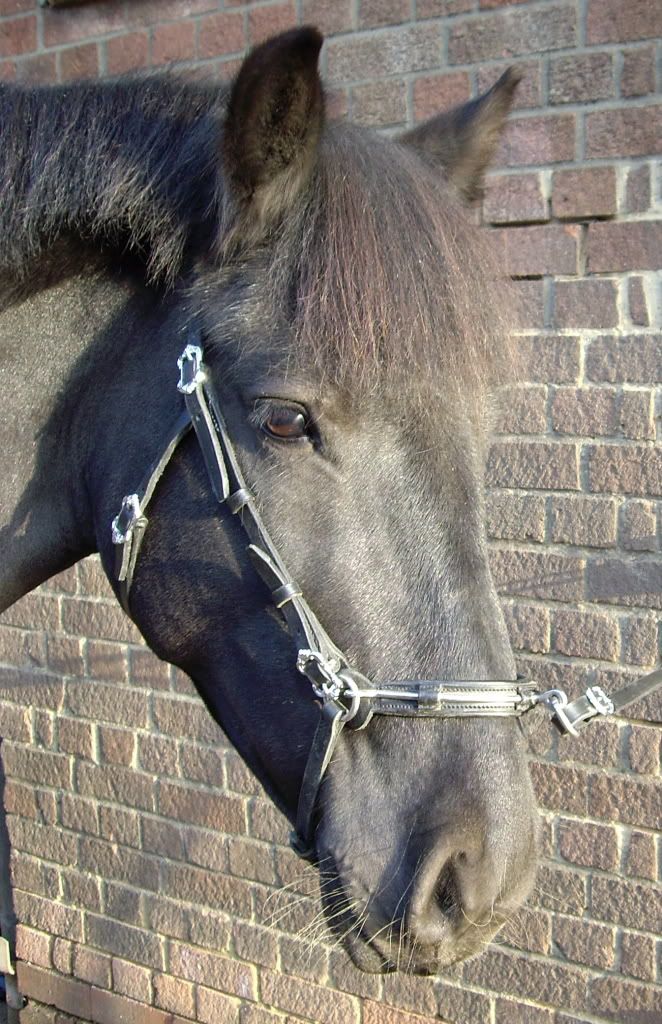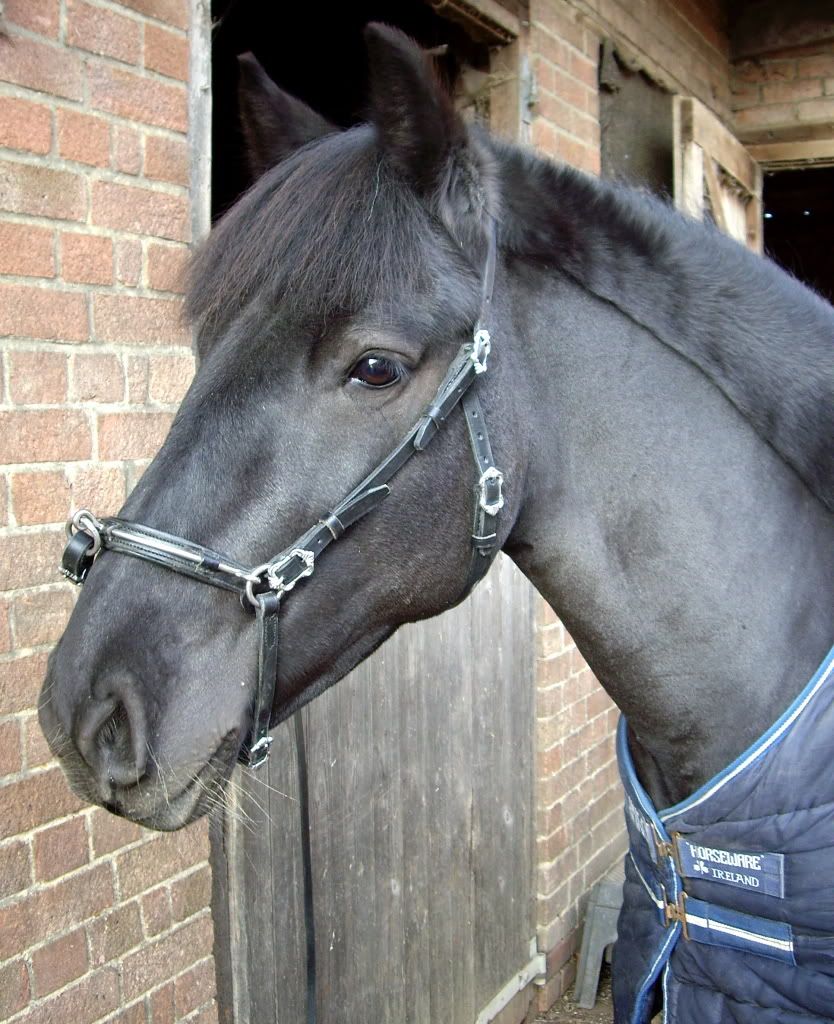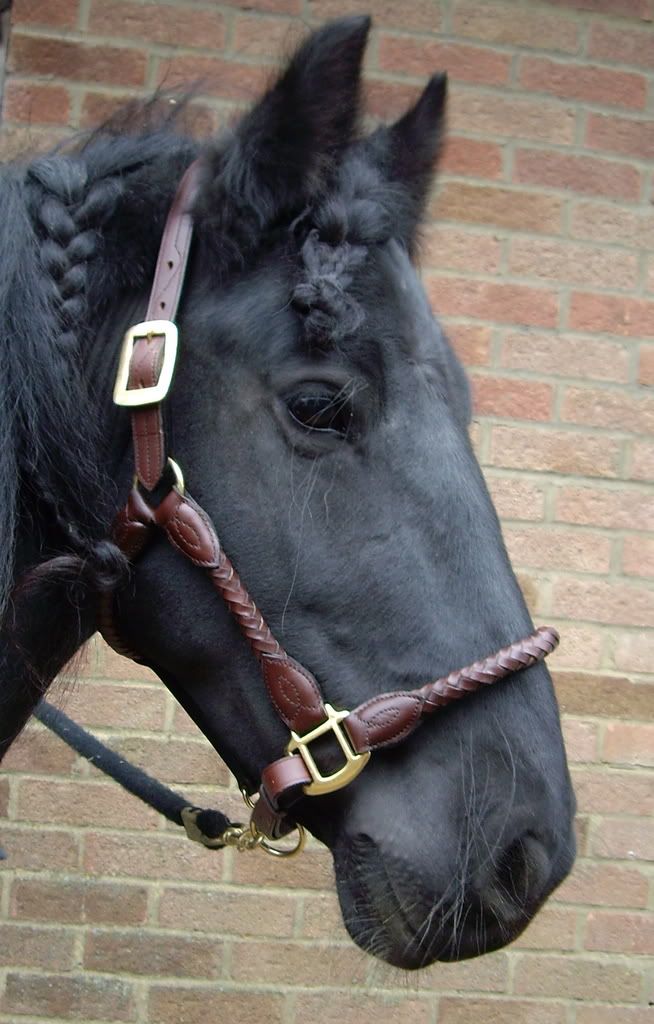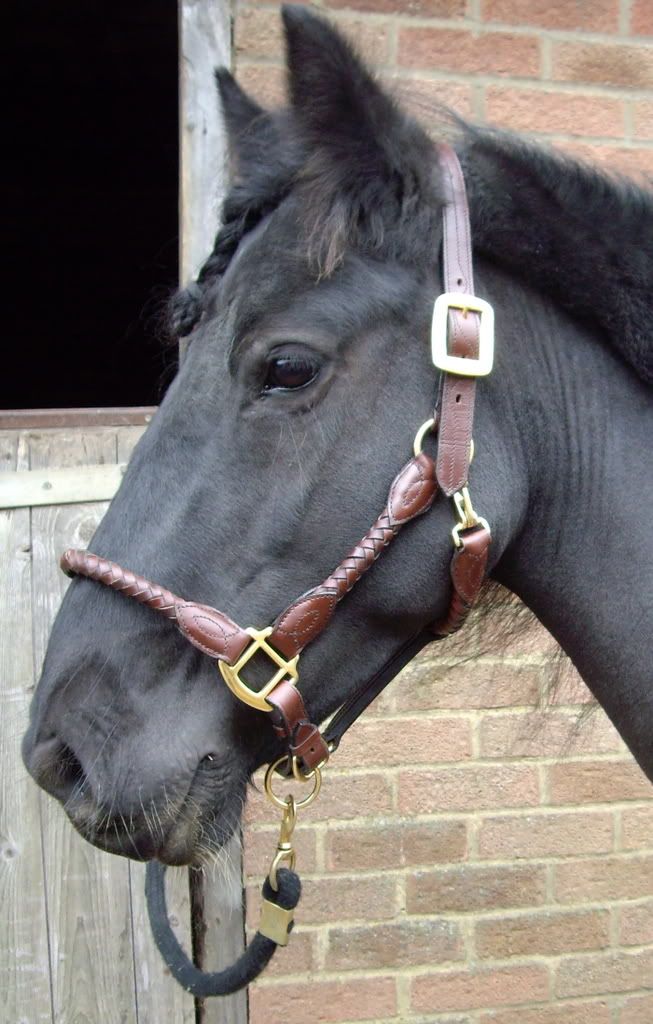This is the story of my quest to train my three Dales Ponies for classical dressage, primarily by using Alexandra Kurland's clicker training methods, with a touch of others such as Philippe Karl and Anja Beran thrown in. I turned to clicker training because I had come up against some issues that I didn't know how to fix and because I wanted to inspire them to become enthusiatic partners. Bella and Jack are all my own work and have never been ridden by anyone else.

Bella, Grace and Jack

Bella aged 6

Bella aged 6

Treat Delivery

Jack aged 7

Jack
Friday, 28 November 2008
I have now watched most of 'Capture the Saddle' and began by trying the mounting block lesson, where you walk with the horse free, walking alongside you, to the mounting block, climb onto it, and the idea is that the horse targets your body with the saddle. When he can do this freely, every time, you know that he is ready and happy to have you get on.
This was very fairly straightforward with all my 3. I always use a mounting block and they are obviously comfortable with me riding them, as they all lined themselves up with very little prompting. The only real problem was that Jack and Bella both tend to do what Oliver does on the DVD and try to get on the mounting block sideways along with me. I'm not sure if this is because they are so keen for me to get on, or if they think that it's their turn to ride me for a change!
Then I went back to the cone circle, which we haven't done for ages. The idea is that you mark out an accurate circle with cones (I have the traffic type of cone) and use it for various exercises, riding on the buckle and only making corrections when the horse isn't going in the right direction, using the inside rein only, to make any necessary corrections, and going back to the buckle the instant they are completed.
When I used this before I circled around the outside of the circle, on the buckle, keeping close to the cones. This was fine in hand, with me between the horse and the cones, but ridden it wasn't the most harmonious exercise.
Jack thought that cones were there to be flattened and would never go around one if he could mow it down, so the circle didn't stay very circular for long. Bella was fairly ambivalent about whether she went around or over them , so wouldn't put herself out to leave them standing. Grace, on the other hand, was very suspicious of them and wouldn't go any closer to them than she could get away with. Spending any amount of time on the buckle with any of them was quite tricky, to say the least!
This time it was a completely different story. Yesterday I began with the exercise shown on the DVDs, riding across the circle to a selected cone and turning around it, using the single rein only, and on the buckle as much as possible. They were all quite good at this. Grace soon got over her suspicions, which were much less obvious this time (she is definitely getting braver), and was concentrating so hard that she did nearly collide with one a couple of times, but it didn't worry her. Bella and Jack understood that the job was to go around them, at last!
The turns were revealing though. Bella and Jack turn on a sixpence, pivoting around their inside hind foot, whereas Grace does a 10m half circle, needing loads of corrections to keep her turning. I definitely need to do a lot more work on turns with her!
Today, after doing the former exercise again, I tried walking, and then trotting, around the edge of the circle, on the buckle, with Grace and Bella (I ran out of daylight before I got to that point with Jack). Grace began by consistently falling in on one rein and out on the other. I thought about what I could try to do to help our combined balance. I tried thinking of sitting towards her outside hind, on the rein she was falling in on, and thought of sitting towards her inside hind, on the rein she was falling out on and that was all we needed - we could then trot all the way around the circle on the buckle!
Bella, my beautiful, clever Bella, right from the start trotted around the circle on the buckle with no corrections, on both reins, carrying herself, in her lovely, springy, enhanced working trot. She is such a superstar!
She did make me laugh earlier though. I walked with her, to the mounting block, climbed on it and, instead of stopping, she must have thought we were going to do some in-hand work first, as she was on a mission and went another couple of strides before she realised I was no longer with her. She immediately went into reverse and then overshot the mounting block backwards, stopped and looked at me. I just stood on the block looking expectantly back at her, in a 'what are you going to do now, to get me to click you?' way. She came forward again and stopped in the perfect position for me to mount. This is in an unfenced school that has quite a lot of grass growing in it - grass being something she gets very little of - and her field companion was calling to her from the yard.
If clicker training isn't the most fun, easiest, most effective way of training horses ever invented, I'll eat my riding hat!!!
Tuesday, 25 November 2008
What I can write about is what happened when learning the technique, for me. The request for a lateral softening of the jaw developed, with practice and repetition, into a lateral softening at the poll, which gradually went right down to the withers, and then led to the inside hind stepping under, thus connecting the reins to the horse's hip. This is all encouraged and allowed to happen - after the initial jaw flexions I didn't have to MAKE the rest happen - it just did - encouraged by the clicker.
Once that is solid on both reins, and I had dealt with overflexing and drifting, I added in the outside rein, alongside the inside rein, and had then established a connection with the reins to both hips - longitudinal flexion. This resulted in an incredibly light, alive feeling down the reins, which makes me very careful of how I use them, because the horses all feel so responsive, responding to every tiny feel down the rein.
I did add in a touch of my own. I had already taught them to step into the outside rein, when doing classical in-hand work, and I used the outside rein in isolation, not asking for outside flexion, but asking them to step into the rein with their outside shoulder. I found this very useful to deal with overflexing, and for straightening, and a bit more refined than the 'hotwalker' technique, but that's just my own addition - it's not something that's in 'Riding With The Clicker'.
On the subject of subtlety and lightness I was told off by Bella today. I was still using a not very discreet 'tuh' sound, with the breath out, to ask for trot from reinback. After a particularly loud 'tuh', which nearly sent her straight into a canter that I wasn't prepared for, the next time of asking Bella pinned her ears back at me with a "Do you think that I'm deaf and stupid, or just plain stupid?" attitude. I apologised profusely and toned down my 'tuh' sound to her satisfaction, and harmony was restored.
How Bella is going to educate me to be refined enough for her in the long term is beyond me. I can only hope that it's not beyond her as well!!!
Sunday, 23 November 2008
I was pleased to see that I had managed to stumble my way through it from the book, with the right results, but it is SO helpful to be able to SEE exactly what I've been feeling and aiming for - that moment when the inside hind steps under and bears enough of the weight of the horse to make mobilising the shoulders easy.
Watching the person learning on the DVD looks nothing like dressage, and it's not very refined at times, but this is the breaking down of the process into it's smallest components, and letting the horse and rider slowly explore and find their way through it at their own pace, and I know from my own experiences that it really can teach them both how to find the 'exquisite' balance that Alexandra Kurland refers as being the end result of learning to use lateral flexions.
Watching this has clarified so many of the things I had noticed when learning single rein riding myself. I could see how first the horse's hip took the inside hind further under, then the shoulders moved up and over, then the horse started to overdo it and drift outwards through her shoulders, both of which I experienced with all three of mine. On the DVD this is corrected by moving the hinquarters over more, to line up with the shoulders again. Not having realised this from the book I did it by moving the shoulders back in line with the hips, using the 'hotwalker' technique (apologies to those who haven't read the book, but it's not that easy to describe). Doing it this way called for much more collection from the horse, than moving the hindquarters back in line with the forehand, but luckily my horses are built for collection. This also explains why we found walk pirouettes easier than turn on the forehand.
I had another go with Grace today and having watched the DVD made so much difference! I knew exactly what was happening and why, and was very confident and positive about my timing of the releases and when something was good enough to click. I realised that, although my technique of getting her to flex laterally in a slightly downward direction had helped free her back up and convince her that it is possible for her to bring her back up underneath me, she is now capable of flexing and staying up and round, which helps her to take more weight behind.
By the end of a short session today she felt consistently much more like Bella and Jack in respect of balance and engagement - like a proper dressage horse. I kept thinking "surely it can't be this easy. Is it just that my horses are all geniuses with incredible natural talent or does it work this well, and this quickly, with every horse?" I'm almost tempted to kidnap one, or both, of my nextdoor neighbour's horses, just to find out!
Saturday, 22 November 2008
I have never known a horse try as hard as he does now to stay calm and steadfast. Yesterday, just as we halted, he jumped very slightly at something, then hopped backwards again, as if to say "whoops, didn't mean to do that, just pretend it never happened". Needless to say he got a jackpot for that!
However, watching the single rein riding on the DVDs has reminded me that I never did that much of it with Jack, and although I have done quite a bit of taking a contact on the inside rein and very carefully insisting that he softens first, before I do, in-hand, I still tend to give him the reins when he gets nervous when I'm riding him.
I really need him to get more like Bella and Grace in this respect, so that he gets into the habit of softening and listening to me no matter what, so I know that he will when it matters. The new DVDs are brilliant for demonstrating the mechanics of single rein riding in great detail, so that's what I now need to concentrate on with Jack, until I can 'tell' him when I need to, regardless of what is going on around us.
Friday, 21 November 2008
Muriel wrote: "Thanks for your answer. I find it fascinating the so many transitions.
But don't you find disrupting?
It is something I notice on one of your video. Do you never get in a "zone" when the horse keeps the pace relaxing into the rythm.
One of my instructors was an endurance rider, and she used to get us into a "rythm" which must have been natural for the horse, it is very relaxing.
Do you do that?"
I answered: "I do when riding out but not when schooling. I'm going for balance before movement, and then clicking, hopefully, before we start to lose that balance. I do go for more duration now, than in that very early video, with movements that are well established, but if I am going to click them, then I have to try to click the best of the movement.
It did feel very strange to begin with, because I used to be one of those riders who trotted around for half an hour trying to get balance through movement, but that seems like such hard work now, for me and for the horse, and so hit and miss.
It CAN still be quite hard, to click and end something lovely, like when Bella starts to offer some passage, but I KNOW that this is the way to make sure that I DO get more of it, and that she's happy to volunteer more of it, which she probably wouldn't be nearly so keen to do if we didn't stop before it became really hard work.
The frequent transitions are also making real improvements in my riding too, because I find that if I can ride the transition well, the rest is easy, and I get a LOT of practise at riding transitions!!!!
Of course there are many roads to Rome (as Hilary would say, if she's reading this!) but, for me, this is the easy, most successful, least physically stressful and most fun way for me and for my horses."
The other thing that I should have said is that when you follow the 'Riding With The Clicker' programme you are, as Alexandra Kurland says, "taking the horse's training apart and putting it back together again, only better". In effect this means that you are teaching the horse a completely different way of going, holding himself in the "exquisite" balance that the flexions help him to find, and that all happens quite fast, so it would be totally unreasonable of me (I think) to expect him to keep it up for more than a few strides at a time, between clicks, to begin with, until his muscles get used to this new way of carrying himself and his rider.
With Bella and Jack I have built this up gradually, a few steps more each time, so they find this self-carriage quite easy to maintain now, but Grace has made massive changes very fast and is using muscles she has never used before, and her body is older and more set in it's ways, so I need to build duration even more slowly and carefully with her.
A couple of days ago I watched a very old video of me schooling one of my previous horses. She was a part bred Arab (palomino - really beautiful) and had a nice, naturally fairly well balanced trot and I was trotting her around for ages. Eventually she produced some really lovely strides and I thanked her and gave her a break in walk.
We had spent about twenty minutes trotting around, practising very average (for her) movement, to get a couple of minutes of beautiful movement.
If I had known then what I know now, we could have spent a couple of minutes warming up with the very average movement, then spent the next twenty minutes practising only the beautiful movement (in short bursts between clicks, to begin with), and I can only imagine how much more we might have achieved, and how much more effortless we might both have found it, if we'd been able to do it that way around.
I used to show her with moderate success. If clicker training and 'Riding With The Clicker' had been around then .................
Thursday, 20 November 2008
Now I just have to find 6 spare hours to watch them!!!!!!!
Wednesday, 19 November 2008
I found today, when I rode Grace, that canter has suddenly become her best pace. She stays round and smooth and it feels as though her inside hind is coming a long way underneath her, which is what she just couldn't do at all before, along with many other Dales who struggle with canter. She has also decided that she really likes cantering and is keen and eager to do so.
This is a pony who couldn't manage an even half way decent canter, and would rather not even try to, for at least the nearly five years that I have known her, and it now feels so lovely that I could canter her all day long!
I am also finding that I can get much better flexion from Bella when I squeeze on the inside rein and leave it hanging loose. She responds with a much truer flexion than if I have a direct contact with her mouth and suddenly my very straight horse, who has never been in Jack's class when it came to flexing, feels much more supple, laterally and longitudinally.
I was also playing with changing the bend and going from one lateral movement to another, through the change of bend, just by changing which loose rein I was squeezing on, and then on bringing her up into collection by squeezing on both loose reins together, with no other conscious aids.
I have realized that what happens is that my hand squeezing has the effect of toning up all that side of my body and I think that it also has some increased 'bearing down' effect, as Mary Wanless used to refer to. I'm going to try to recreate the effect by just thinking of squeezing my hand shut next, without actually doing it, so that I can try to use the effect without having to have the reins dangling. I'm beginning to realise that, because I try to ride without ever closing my hands tightly around the reins, to keep the contact as light as possible, that I may be missing out on a whole lot of other useful micro-movements in my core.
I want to keep riding on a minimal contact, preferably weight of the reins only, but if I can do that and make use of these other aids, while staying out of their mouths, that would be very helpful. Certainly Bella loves being ridden like this and responds instantly and with beautifully soft flexion, both laterally and longitudinally, to this new approach.
Monday, 17 November 2008
I worked them all in hand today, for speed, and it was nearly dark when I took Jack into the school. I have only been working on lateral flexions in walk, along with the 'Monty Python' trot, in-hand, for some time now.
I had just put Bella away and I noticed straight away how much longer his stride is in walk now than Bella's (I hadn't noticed any real difference in the past). When we did some half pass, his stride was so long and sweeping that I had trouble keeping with him. We did some work on his more cadenced trot, which he now manages with less input from me (thank goodness!!). We then finished with some 'long' (my verbal cue) walk - getting him to lengthen by mirroring my long strides in walk. He had his nose really low and his strides were so long that I had to click every three strides because I just couldn't match him - I got further behind with every stride!
This has all happened quite quickly - these slow, ground covering, powerful strides - with the Tai-chi walk work; encouraging him to copy my slow, smooth, deliberate strides. He would have been quite within his rights to be a bit spooky today, after so much time in, and in a dark, wet school, but my version of the Tai-chi walk kept him relaxed and in harmony with me every second we were out there, and in just a headcollar and on a loose leadrope.
I think that I will have to spend much more time doing some Tai-chi walk with Bella and Grace (whose stride looked like a Shetland Pony's after Jack's). His trot may have some way to go to catch up with his sister's, but his walk is now in a class all of it's own!
Sunday, 16 November 2008
He writes, when he trained with Nuno Oliviera and rode his horse, Nuno told him to ride on the buckle and bring the horse up into collection without using his hands or his legs. He says that he managed to do so by thinking and feeling; by bringing himself up into collection, and the horse followed his idea.
He says the following;
"It seems to me that the great ecuyers, or riding masters of the past - Francios Robichon de la Gueriniere (1688-1751), Francois Baucher (1796-1873), and others - were all looking for the same thing:"descente de main et descente de jambe." This French expression means "the relaxing of the hands and the legs"; in other words, a cessation of action.
Baucher expressed it another way; "Make yourself understood and let it happen." This achievement resembles a state of grace, of ultimate perfection, because it lets the horse move and perform on it's own, from within himself. The horse cannot understand this refinement of the aids that makes use of only slight leg pressure and no hands, unless the mental relationship, the mental harmony between rider and horse, has first been established.
Man is supposed to be the most perfect animal because he thinks. However, communicating mentally with horses is actually far easier than doing so with other humans, because the latter have learned to use so many faces, to play many roles. In other words, people cheat....... Horses don't do this."
I'm still not convinced that a lot of this mental communication isn't actually the horse noticing physical changes that happen within our bodies when we think of what we want; the subconscious micro-movements that occur, but if it works, and this level of communication is achievable (and I'm convinced that it is), the whys and wherefores are, to me, academic - I just want to ride like this, and only like this, for the rest of my life.
I also watched Sally Tottles DVD 'Revolutionise Your Riding With Bodysense' and she speaks of using the Alexander Technique to stop the micro-movements that occur whenever you think of something when riding, so that your horse doesn't pick up on them and they don't affect performance. I could hear what she was saying, but I couldn't help thinking how much more attractive the idea of making use of them seemed to me.
Friday, 14 November 2008
Bella's passage-y trot is just beyond my wildest dreams of what we could achieve together! I have put it on cue now (breaths out in rhythm with every stride). I'm trying not to encourage her to produce it too often because I worry that it is too much for a 6yo and she will have joint problems later in life if we overdo it (I'm always worrying about something going wrong with all of them!) but she is so proud of herself and keen to show me what she can do that it's hard to resist going along with her idea.
Grace and I are still working on getting the lateral movements in walk more balanced and supple. Her stiff and hollow sides are the opposite of Bella and Jack's, so that's very good for my riding, and I'm still using the single rein exercises a lot with Grace.
The reason I watched the 'Three-Flip-Three' DVD again was because I couldn't get my head around the Tai-chi walk when I watched it before and wasn't convinced that I really needed it, but now I've done so much experimenting with getting them to copy my strides I wanted to try to understand it. I think that anyone who studied Tai-chi would die laughing at my version of it, but it's amazing how much my walking carefully, deliberately and smoothly seems to relax my horses and hold their attention on me. With Jack especially, he seems to think that if I'm walking like that all must be well and there's no need to worry or look around him.
The only thing that DOES worry me about getting them to copy me is that people keep asking me why I'm limping (this is before the Tai-chi walk). I'm not even aware that I am, so I hope that they don't copy THAT!!!!
Wednesday, 12 November 2008
“When I was learning how to teach horses lateral flexions we used to bash and crash our way through them and it wasn’t much fun for the horses. I was willing to go along with it and teach lateral flexions to my horses, even if the methods were a bit crude….because of what they created for the horses. The lateral flexions enabled us to take the horses into the most exquisite balance which was not only fun to ride and beautiful to watch, but also helped to create soundness in the horses and it felt good to them. They loved the way their bodies moved so, although the process of getting there was not much fun for the horses, the end result was something they really loved.
Now, with the clicker, the process is one which they really, really enjoy."
My own take on this is that, because the flexions are broken down into small, gradual stages, all carefully explained, it is also possible for anyone to teach them safely and successfully, just from following the book and DVDs.
Alexandra Kurland has been photograhed for an exhibition by 'The Literary Horse' because they describe her as a 'significant horse person of our time'. I don't think that is any overstatement.
http://www.theliteraryhorse.com/
I think that I've worked out how this works now. If you click on comments at the bottom of the latest post, I think that we should all be able to read any comments and converse on there, if you would like to. I would love it if we could! If you try to and can't, please email me and I'll try to work out why.
Please let me know if you try to leave comments and can't, as there may be something I have to change in the settings (I wish I understood all the lingo!).
Yes, I'm sure that they are responding to body language and know 'what happens before the next thing that happens, happens', as Pat Parelli would say! That's what Alex's methods do to - teach them to keep on responding at an earlier and earlier stage.
When I watched Philippe Karl on DVD teaching Spanish Walk he said that you should always give the horse a chance to respond before it's touched because horses don't want to be touched (with an aid he meant). That really stuck in my mind and I try to use that with everything I do.
As to whether it would work at speed, I think that it only works at all if they are really concentrating on you, so I think that it will depend on how much of Cutter's attention you have. I would imagine that it's always going to be more difficult if other people ride the horse as well, but then horses are SO clever and, as Alexandra Kurland says "If you can dream it you can teach it".
That's really the answer to everything with horses, isn't it? Getting and keeping their attention? The beauty of 'The Click That Teaches' is that you can do it in such a gentle, horse-freindly way.
Tuesday, 11 November 2008
I have had the maddest afternoon! I worked all three of my pones in-hand, in bridles, with pretend reins. Anyone reading this who hasn’t seen any of Alexandra Kurland’s DVDs will think that I’m barking but they really do notice and respond when I squeeze imaginary reins. I could actually see their heads moving in time with my fingers.
Once, when I put Bella into shoulder in, she stopped. I couldn’t understand why until I realised that I was holding my imaginary reins too tight. As soon as I opened my fingers she moved forward.
G race was still hollowing a bit in downward transitions so I took my hands down and her head came with them, and I could then get her to halt and rein back with her nose on the floor.
I tried halting and then asking them to go forward by opening my fingers, or to rein back by squeezing them shut. I stood completely still so that they weren’t just mirroring me. Back was easier than forward to begin with and I’m not sure if that was because squeezing the reins is more obvious, or because they were being polite and waiting for me, which is what they are used to doing, but it only took a few clicks to reinforce forward.
I was much more comfortable working Jack with imaginary reins than real ones. I usually only to work him in a headcollar and leadrope in hand, because I worry about catching him in the mouth if something makes him jump. It doesn’t seem fair as he tries so hard not to let anything now, and never tries to run off anymore, but the odd unexpected thing is always going to make him jump because of his eye. When I’m riding him I’m careful not to catch him, but I’m not always quick enough to let go of the reins when he’s in hand. Imaginary reins make us both more relaxed and confident and I can use a bit, so it’s more like riding.
I’ve never liked long reining because it’s always made me feel too dependent on the reins, but imaginary reins would be a different matter entirely. I wonder if I were long reining from behind I could use the outside rein on it’s own? I tried in-hand to get them to circle away from me by just using the outside imaginary rein and was quite disappointed when it didn’t work but, thinking about it, I wouldn’t ever just use the outside rein to pull them around anyway, and if they had turned I might have been in the way. Jack wouldn’t be able to see my hand well enough (or probably at all) on one side if I were behind him but I’m going to have to give it a try with Bella and Grace!
I spent the whole afternoon chuckling away but now, thinking about it, I feel really guilty and humble. I always thought that I was a quiet, sympathetic rider but now I realise that I have spent the whole of my working life shouting at horses by comparison. How could I have spent so many years in their company and never even begun to realise just how sensitive, observant and intelligent they really are?Monday, 10 November 2008
I know that I might not be able to ride a dressage test like this but this is about means, not ends. I want their whole-hearted enthusiasm and participation. I want it all to be fun and a game for them, giving them as much room to be a partner, rather than a servant, as possible. My attitude is not 'do this and do that' or even 'please do this and please do that' but rather 'show me what you can do', 'impress me', and, especially in Bella's case 'bet you can't make that even better', to which she always replies 'oh yeah, just watch me!'
When I 1st started clicker training and working through 'Riding With The Clicker' everything was new and Bella was full of enthusiasm. Then, once she knew how to do something I would ask her very clearly and politely to do it and her enthusiasm would start to drain away. She very quickly began to play her own game with me called 'How little effort can I put into this and still get her to click me?' It was a game I could always win, as long as I kept my wits about me, but I didn't want to have to.
The way I ride her now, keeping her mind on me and fully occupied with working out what we are going to do, she is enthusiastic and takes a pride in her work all of the time. She is very clever and doesn't need everything spelt out for her. The way to get her to do anything has always been to let her prove how clever she is and why not? She is! Using that, along with the clicker, makes anything possible.
The answer suddenly came to me. I have spent a lot of time doing the single rein riding exercises in walk and trot, but none in canter, so I am still asking for the canter depart in a ‘macro’ way – moving my inside leg onto the girth and my outside leg behind the girth, sitting towards the outside hind, then asking for canter – in effect treating my horses and my own body as if they are a bit simple and have to be pushed and shoved into position. Although I have only been using breath aids to initiate the canter, I have still been consciously arranging my legs into the right position.
Today I tried it the ‘micro’ way – not consciously doing anything, just thinking “outside hind and breathe into canter”. I could feel my core getting into the right place without me ‘making’ anything move and not only did I feel as though I was leading them effortlessly into the canter but they were suddenly much better at maintaining the canter. Funny that!!!
The other breakthrough was with Grace’s downward transitions. She has always come above the bit and hollowed in upward and downward transitions and although her upward transitions have improved hugely, her downward transitions have been more of a problem, especially into halt. This is partly because she has a longish back with muscle atrophy under the saddle, and because she has never been very keen on stopping and standing, and partly a habitual response to all slowing aids.
We have already worked on standing and waiting, not rushing through things ahead of me, and she is finding it easier to engage her back muscles everyday, so I wondered if there was a ‘micro’ way that I could slow her down and stop her, to bypass the habitual responses.
I try to use the reins as little as possible anyway, and always try to sit as lightly as possible on Grace, to encourage her to lift her back up under me, so it took me a while to think of something different that I could try – some ‘feeling’ I could use which would make her think first rather than resist first.
I tried just thinking ‘stop’ but that had no noticeable result, and then I suddenly thought of dropping the reins entirely and just pretending that I had them and squeezing my imaginary reins – just that, without consciously doing anything else at all.
The result amazed me. Her ears twitched a bit and she slowed down. I stopped squeezing my invisible reins, said good girl and then squeezed again. She stopped, still round underneath me. I immediately stopped squeezing again and clicked and treated her.
Then I tried it in trot. Trot to walk, walk to halt; she stayed round and non-resistant. Then, instead of ceasing to squeeze after she halted I squeezed again. She immediately stepped backwards, smoothly and effortlessly, beautifully on the bit, even though the reins were still swinging free on her neck! She received her well earned jackpot and returned to the yard feeling very pleased and proud of herself.
I'm going to try squeezing on just one imaginary rein next time, and see what we can do with that.
I LOVE micro riding! It’s like having one long conversation with my horses; trying different things and asking them all the time “What do you think of this?” “If I think this, what does it mean to you?” “How does this make you feel?” “Does this help you?” “Help me to try to become the perfect rider for you?” They seem to love these sessions as much as I do and to really appreciate having their opinions sought all the time and, strangely, the answer has never yet been “Just get off and that will do nicely”!!!
Today I tried the single, Tai chi rein work without actually holding the reins at all, and it worked brilliantly. They were softening into lateral flexion and I could even get them to trot a tight circle or put them into shoulder in or leg yeild, by pretending I was using the rein in the Tai-chi fashion. I'm always looking for more ways to get even more from even less. It's one big game for all of us and they never tire of it.
On Alexandra Kurland's 'Why Would You Leave Me' DVD there is some footage of her longreining a horse. You can see her using the reins to get lateral flexion, halt, and longitudinal flexion. You can see her hands squeezing and the horse softening his jaw. Not so remakable, except for the fact that the horse is in a headcollar and there are no reins! She has no physical connection to the horse at all! It took a while for my brain to believe what my eyes were telling me.
I've seen and done loads of stuff at liberty and riding without a bridle but I have never seen a horse soften it's jaw like that without a bit before. I thought that it was just a product of microshaping but I haven't done any microshaping with my horses and yet they are doing just the same when I ride them and pretend to have reins. It's a lot easier riding, obviously, because there is a physical connection, but it's a product of all the repetitions of the single rein riding mechanics and lateral flexions - picking up the rein and sliding your hand down it so slowly that they learn to respond long before you reach a point of contact. I had never thought of using my hands as if I had reins when riding without a bridle before, but this opens up so many possibilities.
| |
“Part of the value of riding on a triangle (single rein riding) is the rider learns to engage her core and to become more aware of the nuances that create feels-like-heaven rides.”
I know that is what ‘Riding With The Clicker’ has taught me to do, and that the reason I can’t now school and talk to someone at the same time (even about what I’m doing) is because I am concentrating so hard on the nuances of balance and movement that are going on beneath me.
It’s happened very slowly, as we’ve worked through the exercises that layer upon each other, creating the balance and control that make beautiful movement possible. I have become a distraction-free rider at the same time as my horses have become distraction-free rides, but I've been wondering about how it happened.
A few weeks ago I could have held a conversation about what I was doing and ridden at the same time. When I began the program I could have ridden and talked about something else entirely. I never decided that I must pay attention to EVERYTHING that’s going on under me – it just happened – just as my horses probably never decided that they must give me their undivided attention (none of this applies to hacking out by the way; I don’t expect their full attention then and don’t feel rude if I don’t give them mine).
So how did it happen? I knew it was to do with the repetition of the exercises and Alexandra Kurland’s instructions to stay with an exercise for a long time, to find ALL that it has to offer. Then I read an article in Horses For Life by Susan Medenica, about training with Karl Bergermann. She says;
“His goal was rather to erase all notions of right and wrong, all hierarchal positioning, in short, all preconceptions, so that the student can begin to experience. In a way, Karl wanted an empty mind in the student so that the horse could enter and begin to teach.”
I thought yes, that was how it happened, but not by emptying the mind with hours of endless, mindless repetitions, as she went on to say that Karl Bergermann used, but by filling it, with hours of fascinating, absorbing ones, that showed me what was needed to produce good balance and movement in my horses; what that felt like and what each layer of getting there felt like. I learnt how to recognise the feelings that led to those feels-like-heaven moments and how to play with reproducing those feelings in my own body, so that I could start to get my horses to recognise and produce the same results quickly and easily, without going through all the layers each time.
For instance, Bella and I can walk around on a long rein and I can now, without touching the reins or using my legs, put the feelings that Bella gives me when she steps forward from a beautiful, engaged rein back, into my own body and instantly get her to step further underneath her body, bring her back muscles up underneath me and draw herself up through her withers and into collection, because we both know the ‘feel’ of it so well. Through concentrating totally on what Bella was doing, in minute detail from second to second, Bella taught me how to ride her and communicate with her, to get the best from her, in the shortest time and with the least effort possible.
It’s easy and effortless and feels magical, and it would have taken me YEARS to get to where we already are, if we’d ever managed it at all, without Riding With The Clicker.
It involved tapping the horse’s hind leg softly and repeatedly with a whip until it picked the foot up, and then carrying on tapping to get it to keep the foot in the air. I thought that this would be a useful exercise to teach my horses but that I could get easier and better results by using the clicker.
I tried with Bella last night and Jack today. I stood alongside them, looked at a back leg and slowly (to give them a chance to recognise the chain of events and respond at an earlier stage as quickly as possible) extended my arm, pointed at their hind leg and then tapped very lightly with one finger midway between stifle and hock until that foot began to leave the floor – click, treat, praise, begin again.
With both of them I didn’t get beyond the pointing stage on the second attempt before their foot was in the air. A few goes later, when I knew that they definitely would pick their foot up, I introduced the word ‘up’ to the looking and pointing, and a few tries after that I only had to look and say ‘up’. I then started the other side but never needed more than the looking and the word ‘up’.
Bella already finds this so easy that she will keep her foot in the air until I click. I’m not asking for more than a few seconds at the moment, but it seems effortless for her. It’s a bit more effort for Jack, who has to rearrange himself occasionally, so I think I need to give him some more time before withholding the click to keep his foot off the ground. Both of them end the exercise with both hind feet much further underneath them than they were to begin with.
With both of them I’ve had to ignore, to ‘weed out’ a few tiny hints of a cow kick. These were only recognisable from an outward twitch of a stifle, but might have got bigger without clicker training to clarify the point!!!!
A link to the Jane Savoie exercise;
http://www.youtube.com/watch?v=QUm_jcuBAag&feature=related
| |
All the ridden dressage training I have done so far I have done by feel. I have had no dressage training myself and I have no trainer, no ‘eyes on the ground’ or mirrors, so it’s the only way I CAN do it, using photos to check on whether my feel is producing the results I am after.
I learnt how to ride the lateral movements by finding a way to communicate to my horses which movement I wanted (they had already learnt them in-hand), getting the feel of the movement, then trying to improve on the basics by improving on the feel. This was all while I was concentrating on what to click and timing the clicks, plus marvelling at the feelings going on beneath me, so my brain had very little attention left for controlling my body, which was mostly left to just to work it out for itself.
The way I have learnt to access really good lateral movement in walk is primarily by accessing and influencing the horse’s back, hip and stifle. This is where nearly all my concentration is and my body has learnt to ‘talk’ to my horse’s bodies by using feelings in the corresponding part of mine, so I have been using my hip and ‘stifle’ to take my horse’s hip and stifle under and across. In leg yield and shoulder-in (just under, without the across, in shoulder in) by using my inside hip and ‘stifle’ (and the thigh bone between them) and in renvers, travers and half pass, my outside hip, thigh and knee. This doesn’t involve shuffling across the saddle or unbalancing them; it’s very subtle bone rotations and actually improves their balance by further engaging their hindquarters.
I have come to realise that is what I do all the time now; not just in lateral work. Now my horses understand about softening into a lateral flexion I find that if their backs and hindquarters feel right then everything else pretty much takes care of itself.
I can’t make thinking primarily about using my lower leg with the swing of the belly work for me, for lateral work, even in walk. This is because, to me, my lower leg would be influencing from the hock down and it just doesn’t give me the right feel, in myself or from the horse. I can get some lateral movement but it’s not the effortless picking themselves up through their withers and gliding over, with big, swinging strides, that I’m used to. I’m sure that it works perfectly for other people and perhaps I am getting something wrong, but I need something that I can use and preserve the joyous, beautiful feelings that I am used to; something that works for me.
I’ve also realised why I haven’t been able to make what does work for me in walk, work in trot. Like my horses I have learnt the patterns and sequences of the movements and when we are trotting and I try to go sideways, I try to use the patterns that my body knows so well in walk, but I haven’t upped the speed and energy to match the pace, so, not surprisingly, we end up back in walk. I need to put my learnt 'feelings' into fast forward, to get them into the rythm of the trot. It’s very hard to begin with because I’m trying to access a feel that I haven’t experienced yet, but I had this trouble to begin with in walk, and once I knew how it felt, improving on it was easy.
I have now managed to get a couple of good strides, by keeping my brain occupied with timing the click and noticing what is happening beneath me, while my body just speeds itself up and puts in more energy, so I’m getting there now. As soon as I start to think about what I should be doing I start to lose it, so I need to keep my brain otherwise occupied until the feelings of the movements in trot are ingrained.
I read the following, by Max Gahwyler MD. First, these are his credentials:
“Kinetics is a branch of science that tries to explain the effects of forces, such as gravity, on the motion of material bodies, such as a horse and a rider. As a physician and dressage rider, Max Gahwyler has a unique perspective on kinetics and the physics of riding.”
In his book ‘The Competitive Edge III – Gravity, Balance and Kinetics of the Horse and Rider’ Max Gahwyler says;
“An outstanding European friend and rider admonished me many years ago, "Never push your horse around with crude aids - just take him with you and ride the movement you want ahead of him."
I'm not for one minute implying that using the lower leg with the swing of the belly is the former, but the later is what what my body tells me is the right way for me, and my horses (as Alexandra Kurland recommends I go to people for opinions but to my horses for answers) seem to give me a big thumbs up when I ride in this way. It may not be right for anyone else but, at the moment anyway, it’s the only way that ‘feels’ right to me.
It started when Bella was trying to get me to play ear to hand targeting when I was trying to skip her out late one night. I thought I would try something else and put my hand across her nose, stuck my head forward and put my cheek next to hers. When she stopped wriggling I clicked her, let go and treated her, and began again. About 10 clicks later I only had to stick my head out and she would put her cheek next to mine, without my touching her, and freeze there. We both stayed stock still, not even mouth movements allowed, and built up duration to a good 15 seconds or so in that first session.
Then I did the same with Jack and they both LOVE this game! Sometimes when I'm minding my own business this big eye will suddenly loom up, right next to mine, and freeze there, with an innocent
 expression. Bella looks as though she is laughing when she does this, a 'come on, you know you can't resist, hand over the goodies' look on her face, and she's right!!
expression. Bella looks as though she is laughing when she does this, a 'come on, you know you can't resist, hand over the goodies' look on her face, and she's right!!I have found that if I assume the same attitude when riding, long reining, etc. they pick up on it straight away and freeze, and will even do it when they still have food in their mouths, and stop chewing. It's been one of the most useful things we've done and they have so much confidence in giving me their heads now. It even makes Bella go quite soppy, and she is not that sort of horse at all by nature.
Jack has just started to improve on this even further by turning his head on one side and resting his ear against me at the same time, combining two different games, no doubt expecting twice the treats!!! He looks SO sweet!!!!
I just wish I was half as clever as they are!!!!!!
I have had such a fantastic afternoon today. I was a bit disconsolate, wondering if I was aiming for all the wrong things and trying to improve on methods which were perfectly adequate and didn't need improving on, so I did what I always do when having self doubts - I rode Bella.
She is my fairytale dressage horse! She is beautiful and enthusiastic and gives me more satisfaction and joy to ride than any horse I have ever known. Her trot, to me, is breathtaking now, 100 times better than her natural trot, and we have achieved that together, just the two of us and a clicker!
I have been concentrating on keeping her round and soft underneath me, and playing with slowing her trot with my seat, keeping the energy and increasing the bounce. I may be kidding myself but at times it feels almost passage-like, not that I have ever experienced passage, but it's starting to feel like passage looks like it would feel like, if that makes any sense!!! If I am kidding myself I don't care - it feels magical!!!
She is also going to have the most MASSIVE Spanish Walk! Bella doesn't believe in half measures!!!
Jack is now consistantly light on his feet in trot, with an increased moment of suspension to every stride. He's not dancing to the same extent that Bella is yet, but he's catching her up fast, and there's so much more of him to manouvre! His concentration throughout this 'silly runs' work has been absolute, even in the face of extreme wind and outside distractions, which have been unavoidable to fit in three sessions a day. Time to see if he can do the same with the burden of me ontop!!!
Grace felt so balanced and soft in trot today that I thought I would just give a canter transition a go. It felt just like Bella's! I couldn't believe it!!! When I clicked, the stop felt just like Bella's too! I tried a few on each rein and they were slightly better on the left rein than the right, but all unrecognisable from the run-ins, which were the only way she thought that she COULD get into a canter before. I haven't even done any work on this on the lunge first - just used Philippe Karl's weight aid of sitting towards the outside hind and, added on to Alexandra Kurland's balancing work, WHAT a difference!!!
I still find it hard to believe that a 12yo could learn to re-balance herself so quickly and completely, and I'll swear that the muscle atrophy under the saddle is already starting to reverse.
It is definately time for me to do some more reading and video watching, before they all leave me way behind in their dust trail!!! Bella already has!!!
Grace has always had a short, choppy trot, slamming her feet down and very tight in her back. She pushed herself into a trot off Sher shoulders, coming above the bit as she did so, and all her transitions were jerky and unbalanced.
I started trying to show her a different way of going by walking alongside her, with her in a headcollar, and getting her to follow a downward feel on the leadrope as she went into trot. She understood this quite quickly, although she wasn’t sure that she could get into a trot while lowering her head to begin with.
Once she discovered that she could, her transitions in and out of trot became much softer and smoother, and she became much more eager to get into a trot. Apart from hacking out a few times this is all I have done with her for the last week or so, at least one session a day, sometimes in a headcollar and sometimes in a bridle.
Yesterday I rode her in the school and, after getting her to soften to the inside rein in walk, tried to get her to follow a suggestion of a downward feel on the inside rein as I asked for trot. Obviously I can’t actually use a downward feel from the saddle, but she understands the suggestion from the Tai Chi Rein work and head lowering exercises she has done a little of.
I couldn’t believe the difference that this has made to her trot! I was confident that the transitions would be a lot better, but her trot!!!! It’s as though her back has completely freed-up and she is suddenly swinging along, light on her feet and up in her back. For the first time EVER I didn’t want to get off her and had to make myself stop, before she tired out newly in use muscles.
She was the same today. Not only is she suddenly using herself correctly but also her mouth now feels beautifully soft and responsive at the end of the reins and she is giving me her undivided attention at least 95% of the time. She really does feel like a completely different horse. She has a long way to go before she develops the cadence of Bella’s trot but it’s a fantastic start and I thought that, if it were possible at all, at twelve years old and with back muscle atrophy, it would take much, much longer.
I don’t think I’ll ever quite get used to how quickly, easily and completely you can make really radical changes using clicker training!
I tried lowering my criteria, to up the rate of reinforcement, but I just couldn’t inspire her.
I thought that perhaps she was a bit tired, as she had been rampantly in season for a few days (and still was), but it still felt as though there was something missing; something I wasn’t doing. I ran through a checklist of breath aids, the way I was sitting, etc, and suddenly it occurred to me that I usually give her loads of verbal encouragement, when she is really trying hard (which is 99% of the time) and, because people were watching, I must have felt a bit inhibited and had gone quiet on her.
As soon as I could justify it I gave her the usual ‘good’ and ‘good girl’ and ‘YES’, all in the warmest possible voice, and I immediately felt her begin to blossom underneath me. Even the people watching could see the difference straight away. The difference in her body and attitude felt magical - as though she was coming up and filling out under my seat as I spoke.
It was another lesson learnt for me because, although the scientific explanation is just that we have a very effective bridging signal, the fact was that the clicks and treats alone didn’t mean very much to her without my verbal enthusiasm and praise thrown in.
Until that moment I had not realised how much it meant to her and I feel closer to her than ever now. Bella appears to be very self-contained and independent: she has never been a soft, very affectionate horse like Jack and Grace, so the fact that my voice makes so much difference to her (I am not always very consistent with the words I use but I am with my tone of voice) I find really touching.
More proof to me that clicker training becomes less and less just about the food.
Then I remembered that when I couldn’t get him to lengthen his stride in walk I taught him to do so by walking alongside him and getting him to mirror me. I am always doing this sort of thing now; leading them on a loose leadrope and getting them to copy me, stopping and starting, going forwards and backwards, taking big steps and then little ones and alternating between the two. Perhaps he would copy me if I developed some cadence in my own trot!
Oh dear!!! It is working! I trot alongside Jack taking huge, bounding strides, springing from one foot to the other, looking like something from Monty Python’s Ministry of Silly Walks (or rather Silly Runs) and Jack, bless his little cotton socks, gets his head down and trots thoughtfully alongside me, concentration written all over him, doing a refined, sane person’s version of my deranged, exaggerated trot. We are practicing this several times a day, as I want it to be the only trot in town before I try to get it under saddle, and I really think that it is going to work, but it's killing me!!!!
I obviously had no cadence in my trot at all before, as I am always running about with them, but this bounding along is doing me in! I don’t have a muscle from the waist down that doesn’t ache, and the worst of it is I think that this would be a really good thing to try with Grace as well!!!!
It has certainly made me appreciate just how much effort Bella is putting in, as this degree of cadence is not much more natural for her than it is for me! I had thought that I had built it really slowly with her but it would take me years to get used to running like this!!!!
I am very excited about how well this is working because Jack is already exploring different things that he can do in trot, copying me taking short, slow, high steps and big, slow, long steps. Just his knowing that these are things that he can do and will get clicked for will make it much easier for me to encourage him to try them from the saddle. He is also learning to develop the sort of concentration and focus that helps him to more effectively block out outside stimuli while he is working and getting more like Bella in that respect every day. If I can get his trot as good as hers too, it will be worth every aching muscle and the ever-present danger of someone seeing me and sending the men in white coats round to take me away!!!!
| |


I also have one pic of her canter transition. I wasn't going to post it because I can't stand the way I am sitting and will never be able to look at this page again if I put it on here, but I wanted to show you how Philippe Karl's DVDs have helped us, so I have cropped me out! I had my chin stuck out and my back hollow - I never ride like that usually - it was awful!! If I wait until OH is free again, and until the digital camera gets the right moment again, it could be ages until I get another! She is like this on both reins now and always a correct lead.
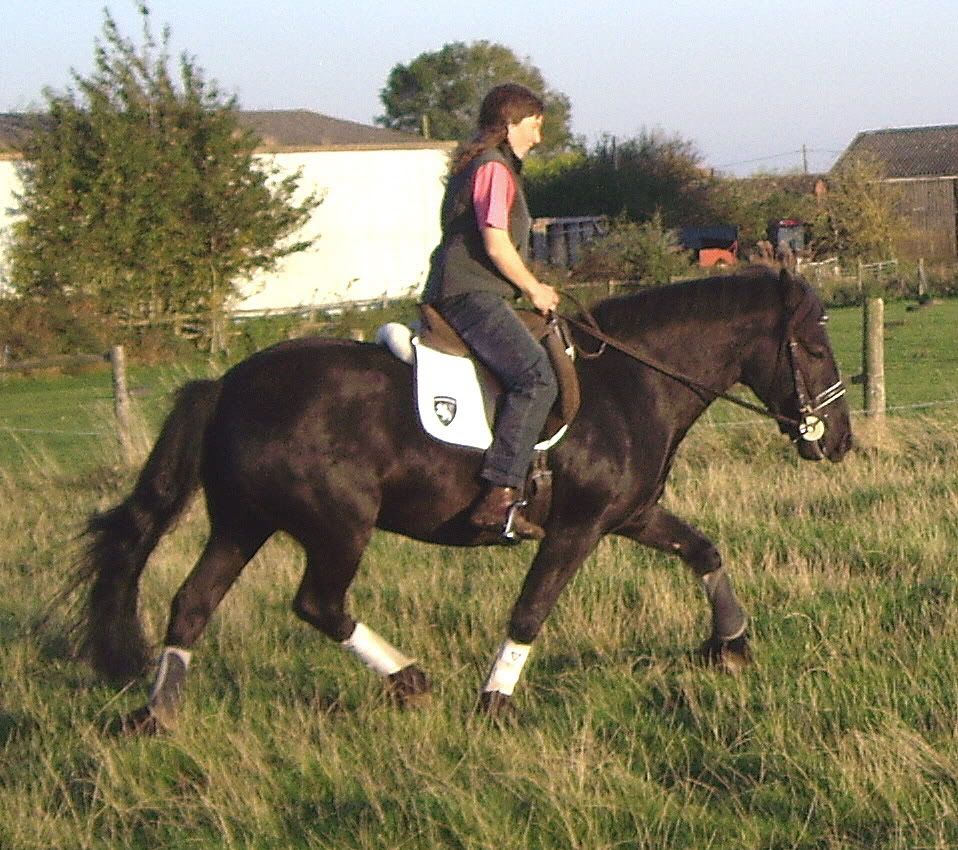
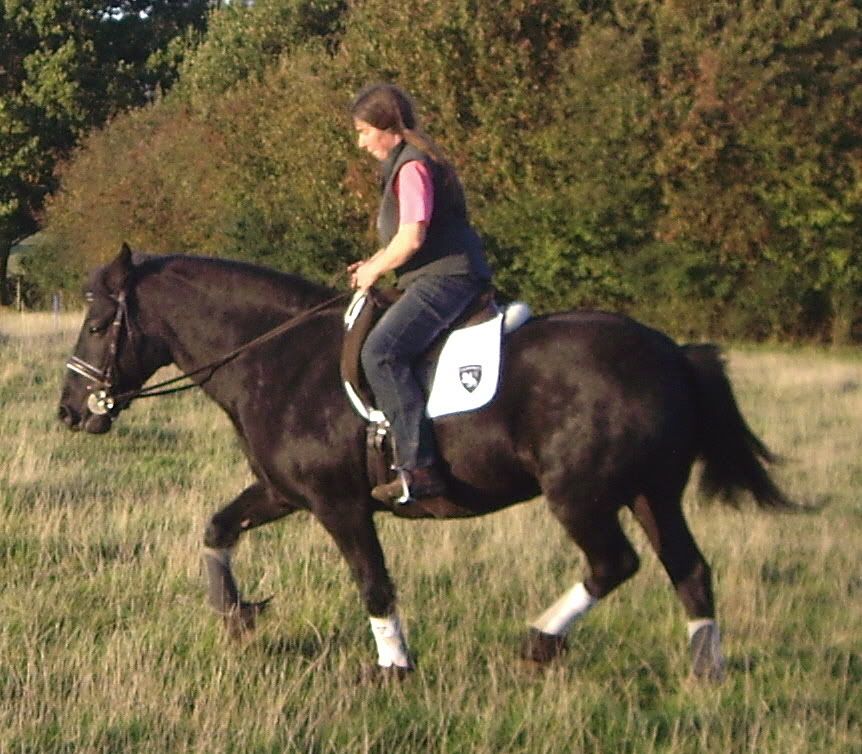

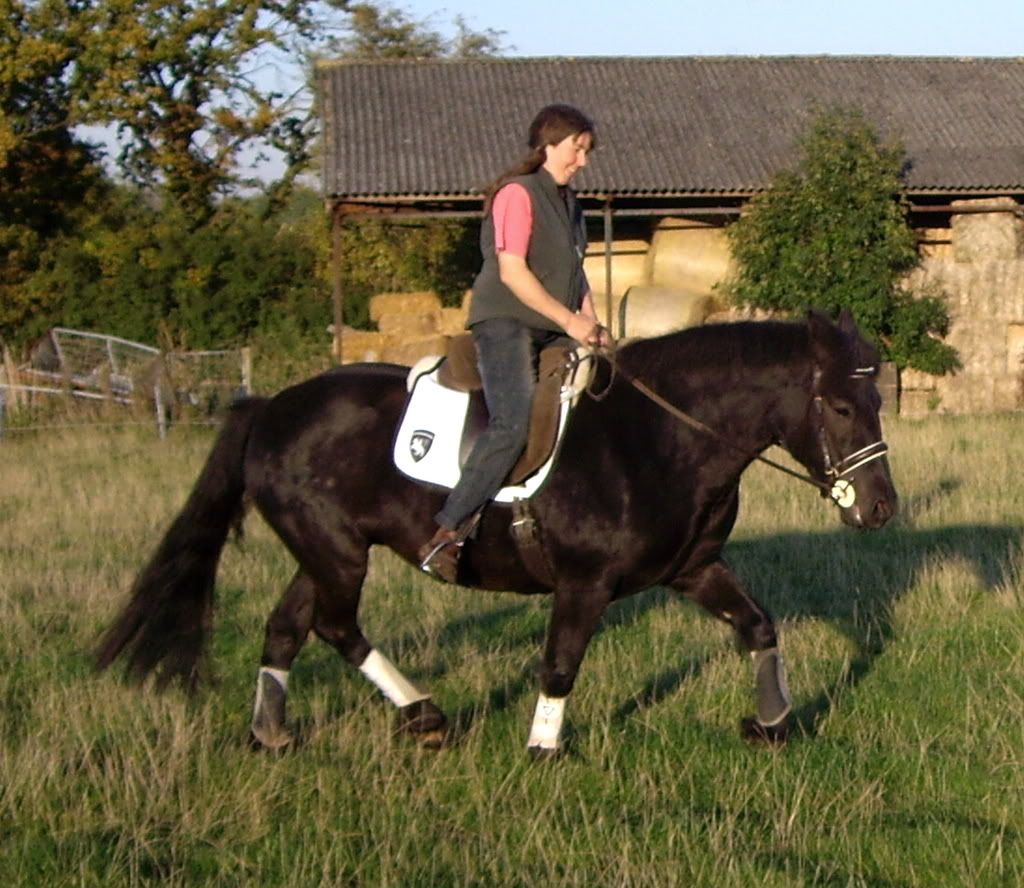
We had our third ridden schooling session today and I can't believe how quickly she is tuning into me and understanding what I am trying to achive. We have just started to try some ridden lateral work and it is making the world of difference to her balance, softness and attentiveness. She has always been rather impatient and tends to rush everything, and is just starting to slow down, wait for me and use her body in a more contolled way.
I have LOTS of pics from today, beginning in typical Gracie style; paying no attention to her rider and admiring the scenery (her nose looks a bit fuzzy because she is a slight headshaker and wears a nosenet):
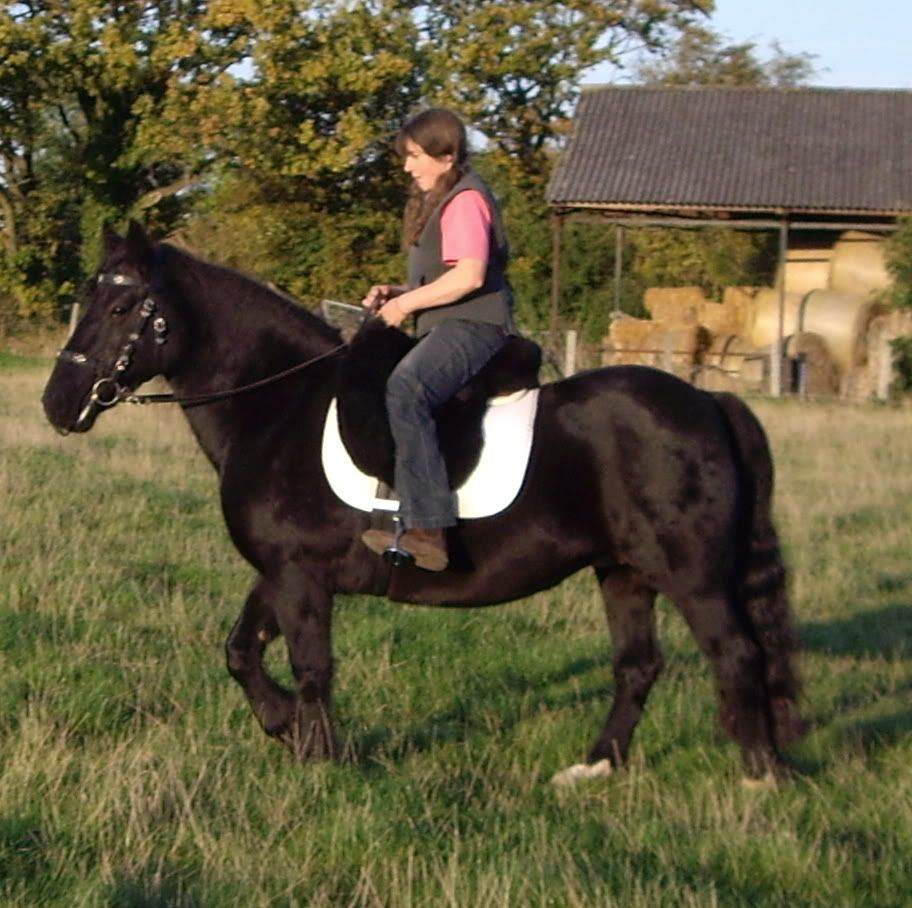
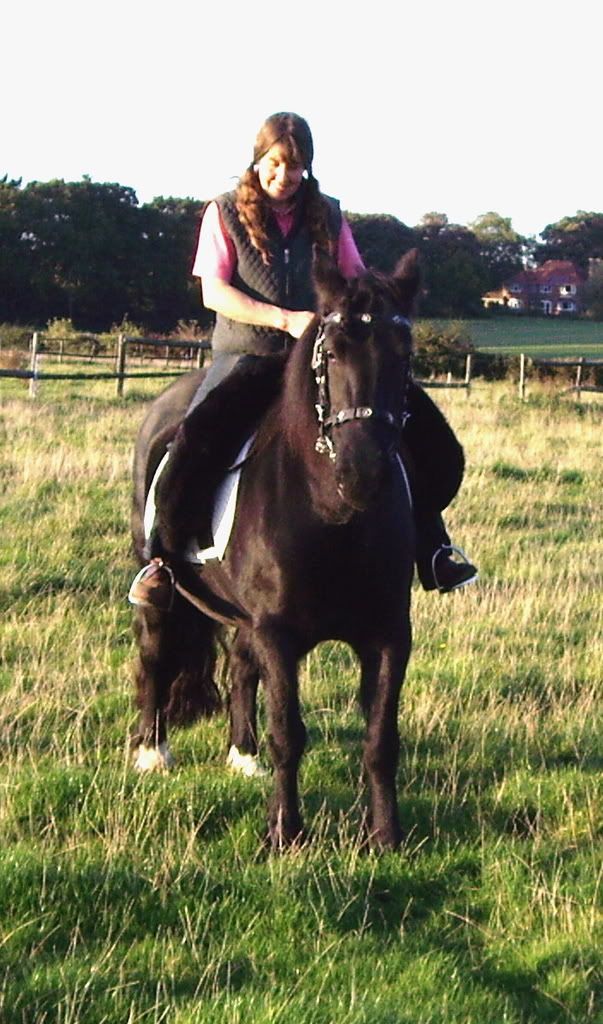
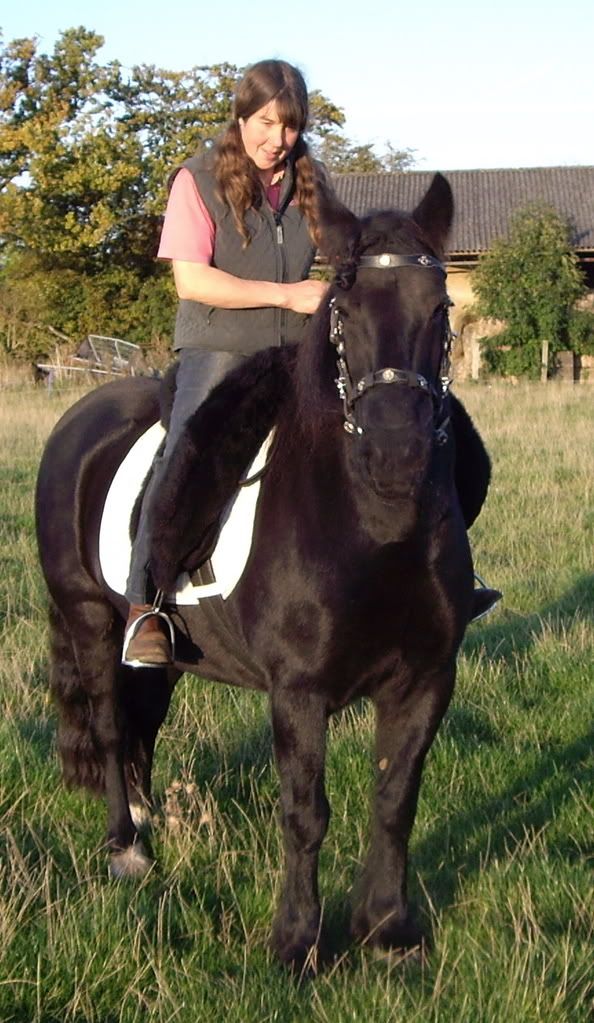
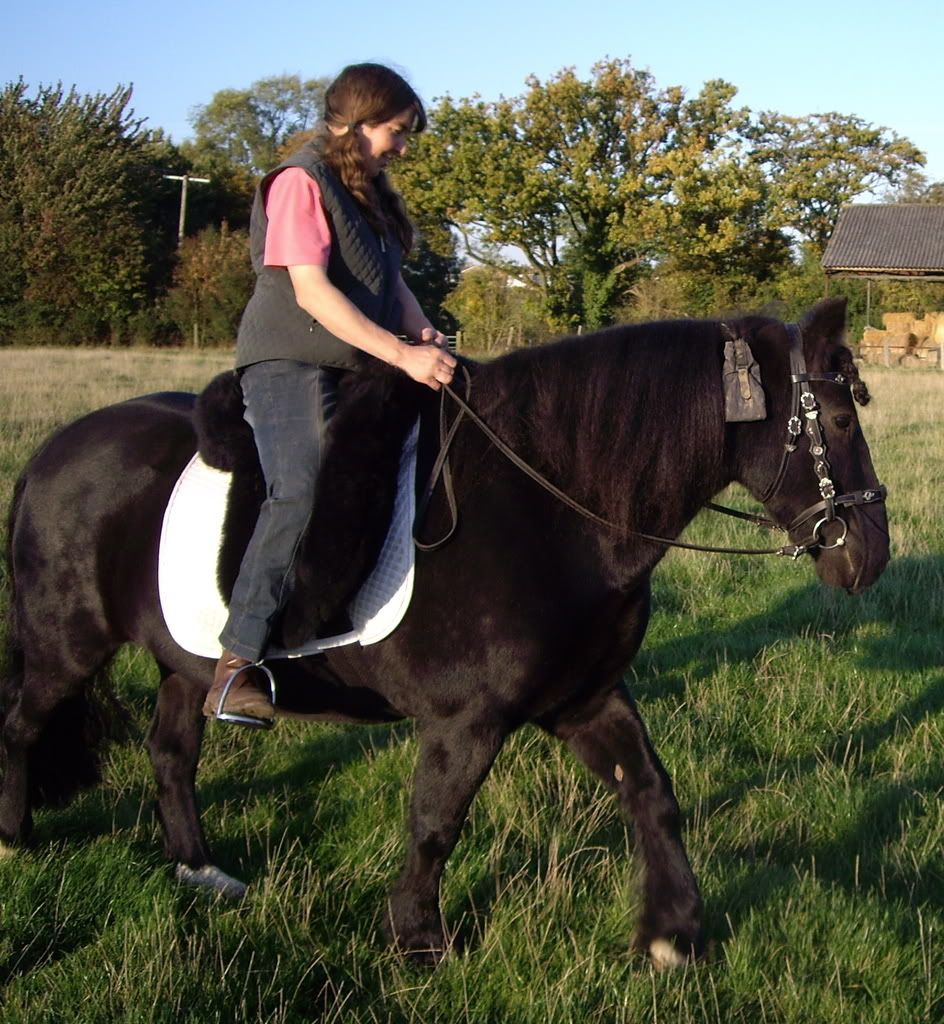
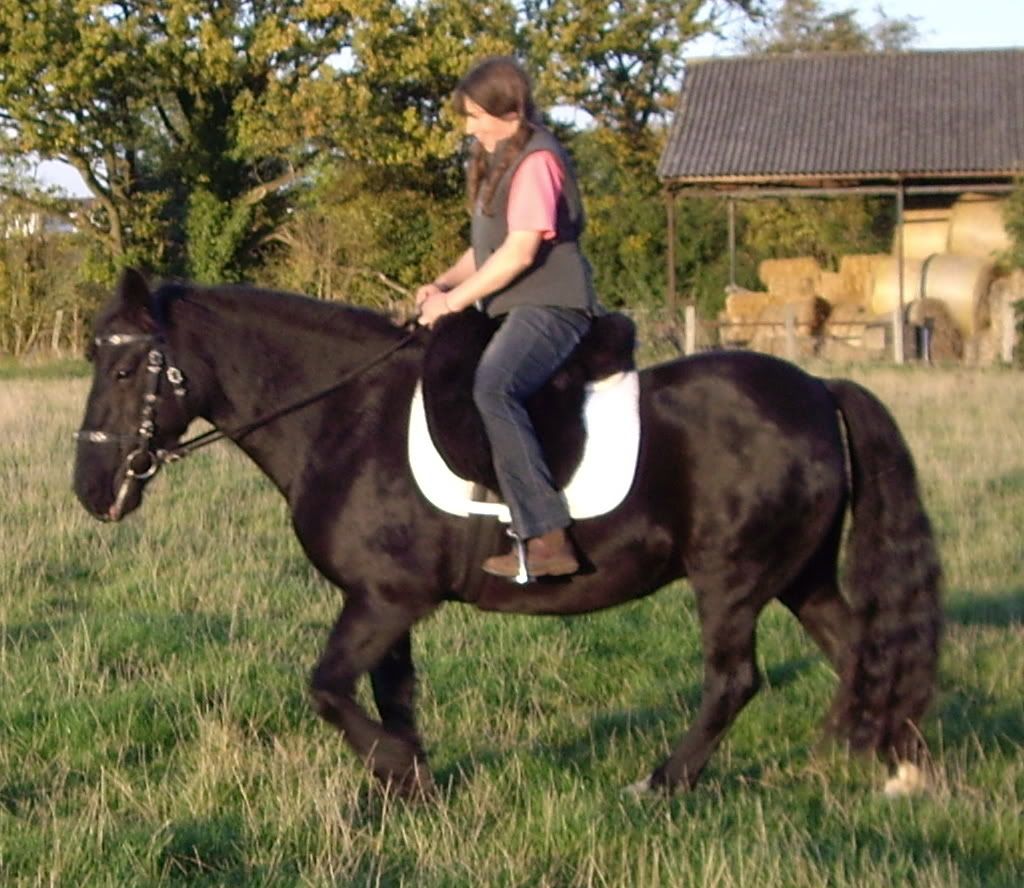
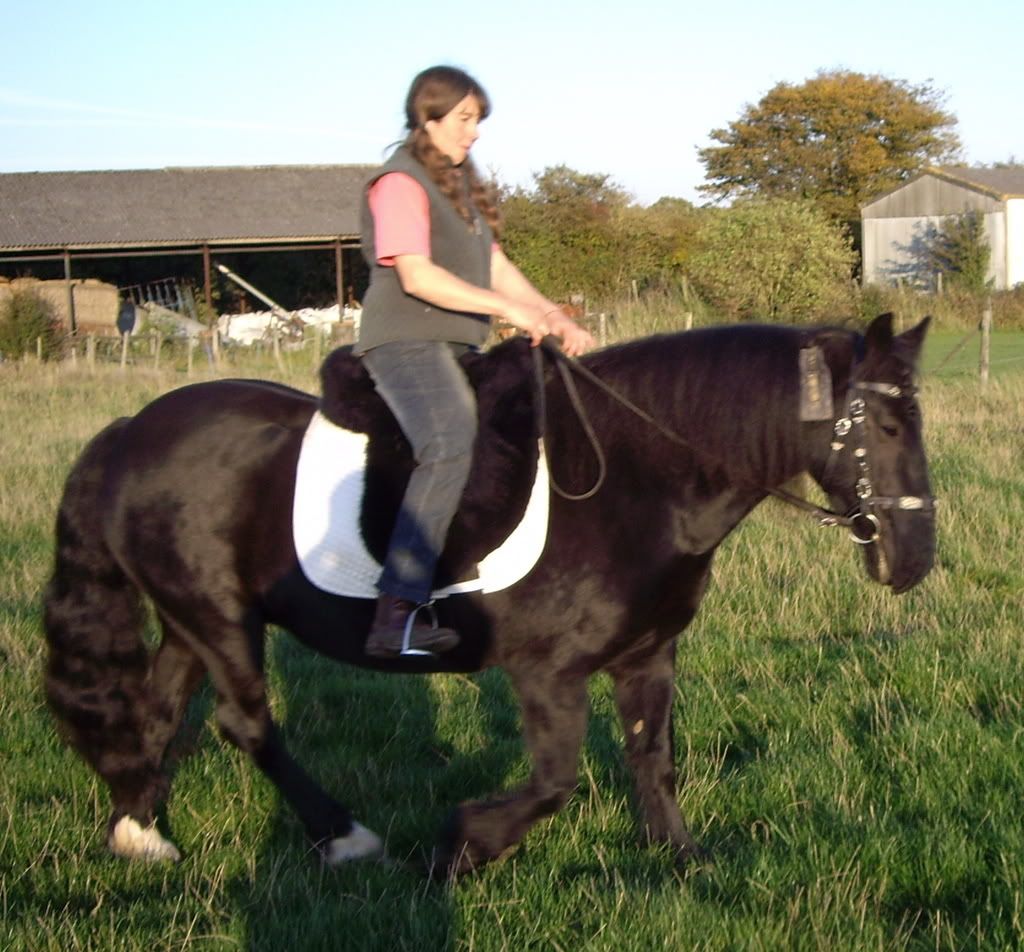
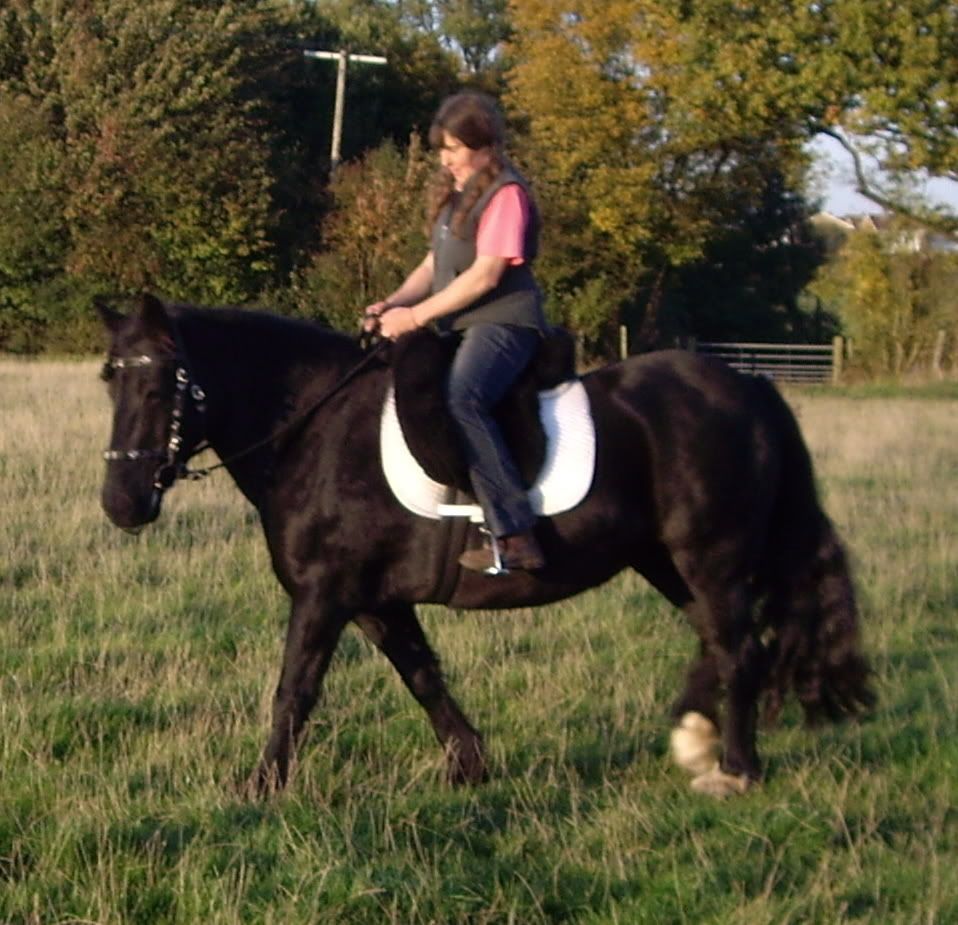
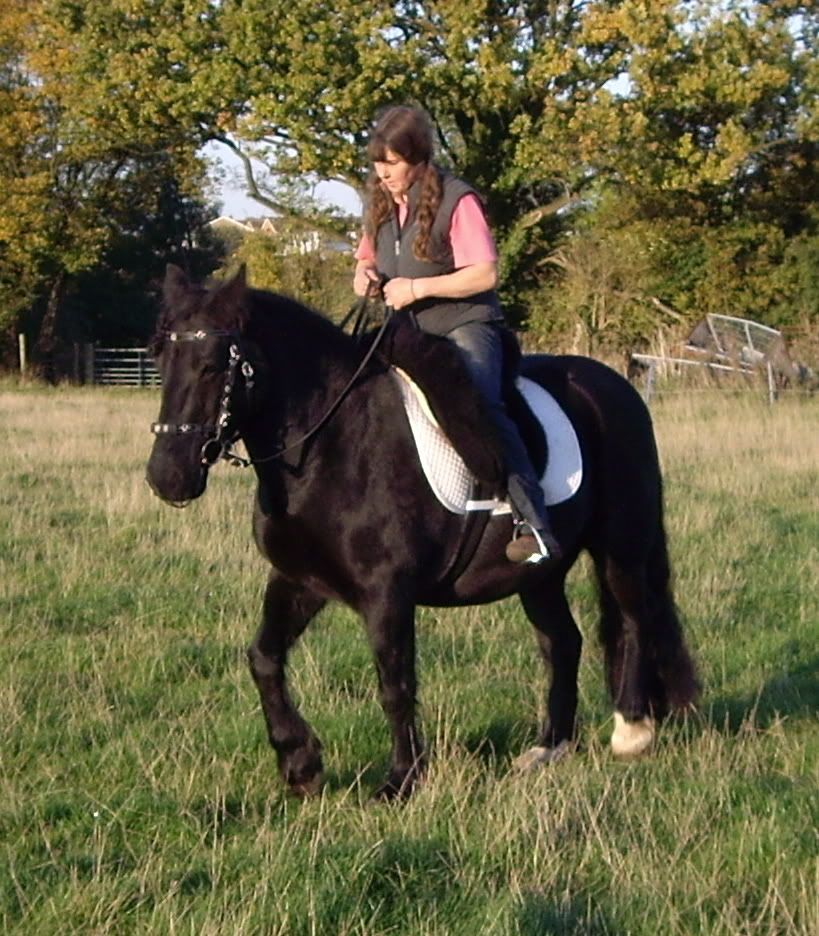


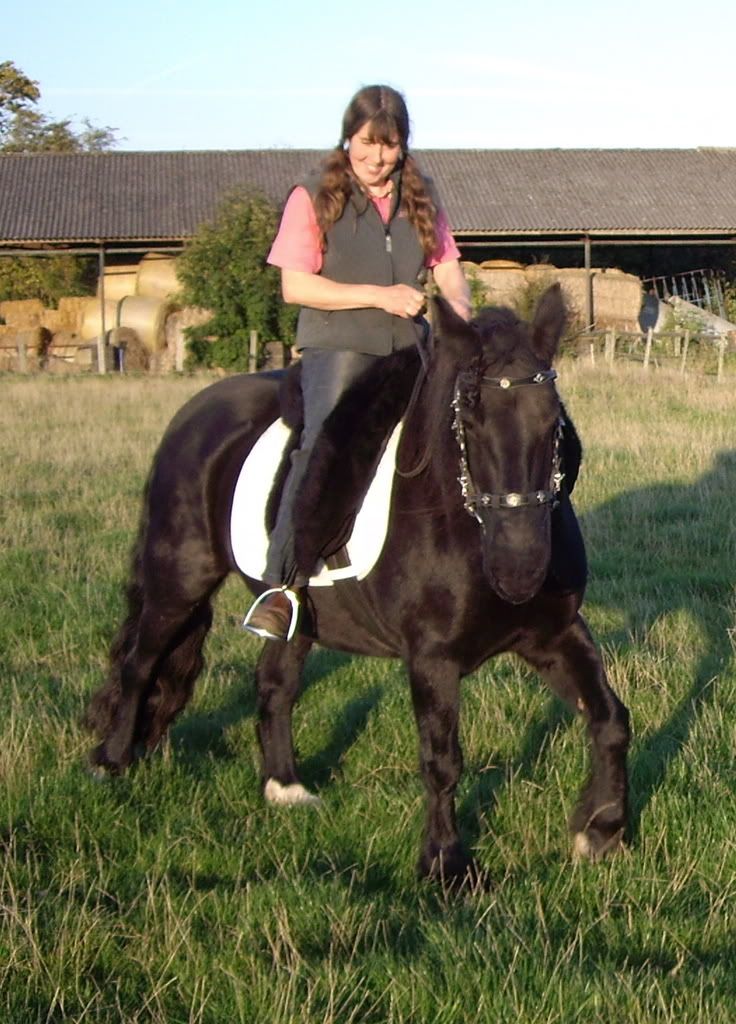
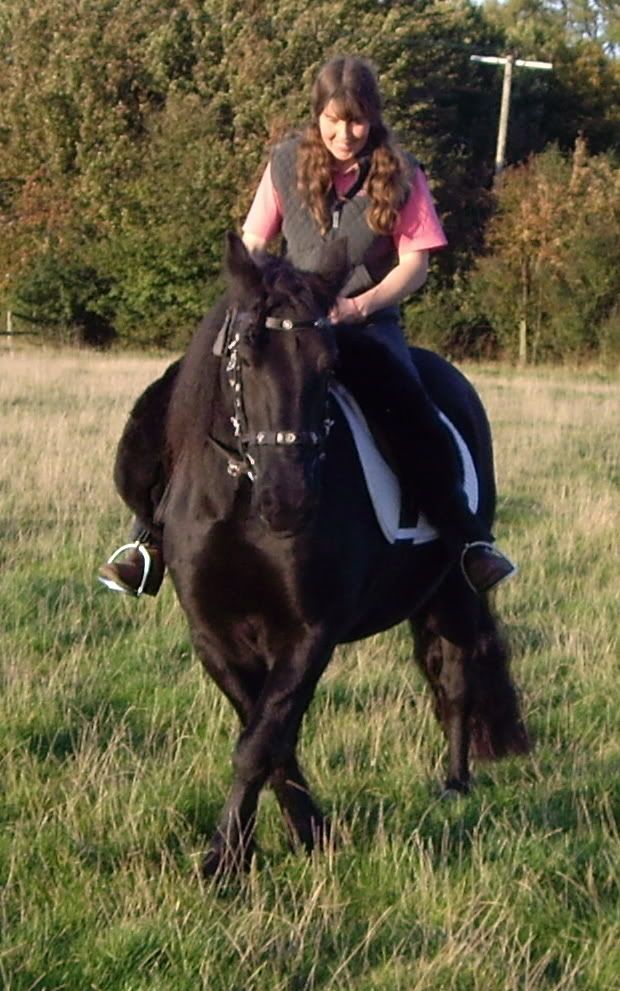
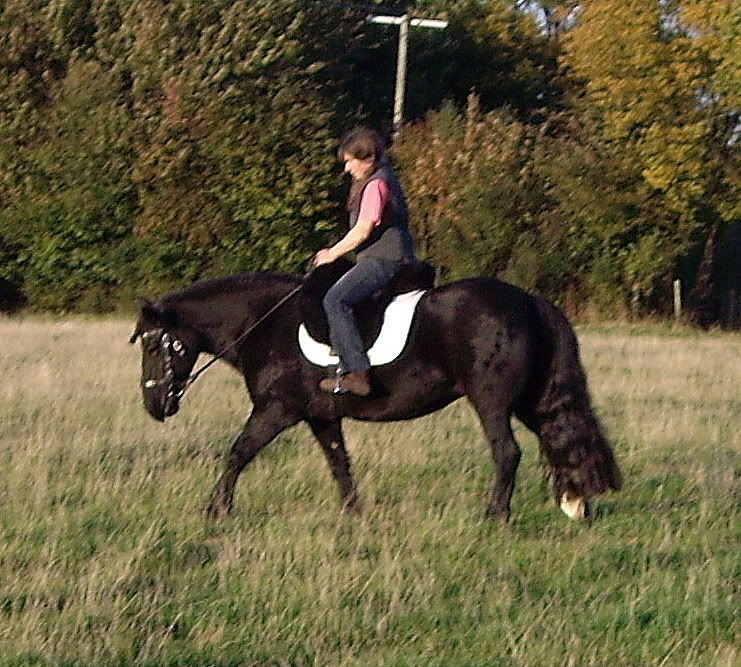

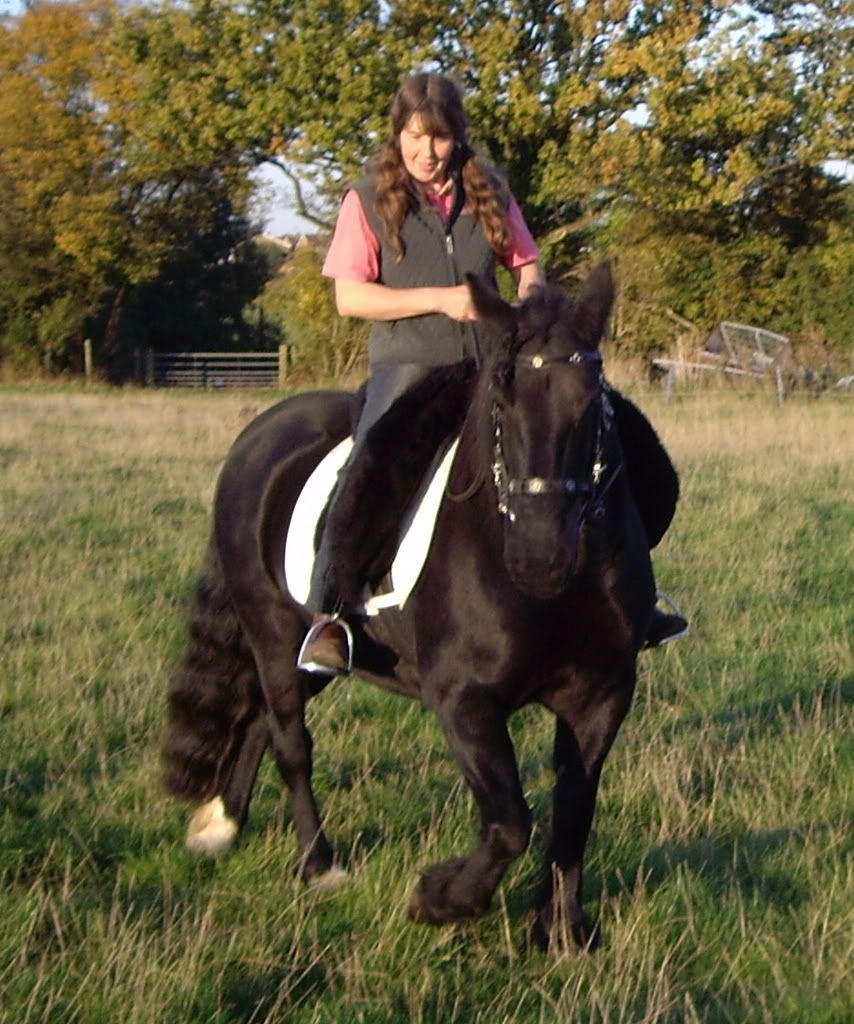

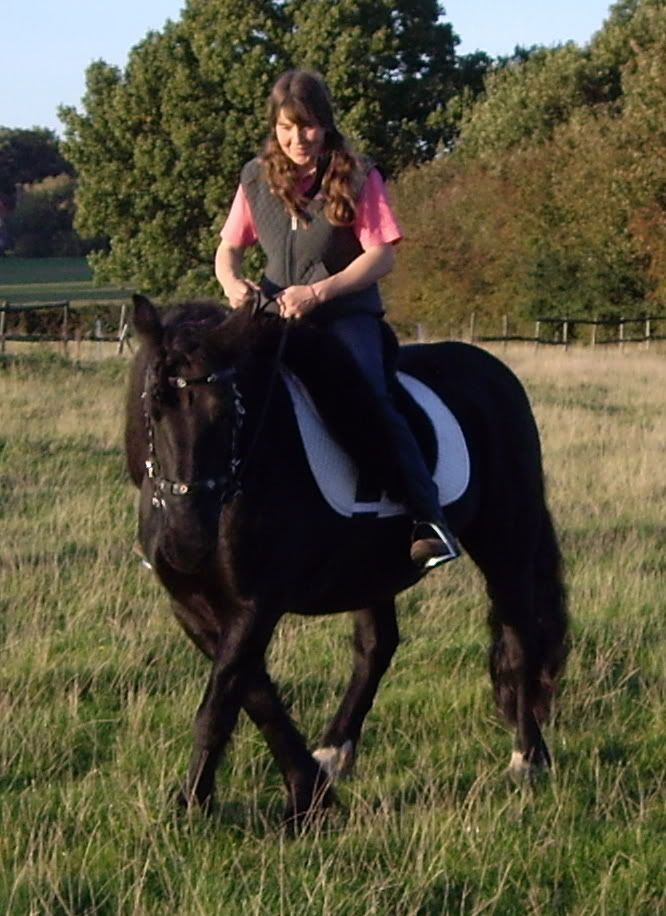
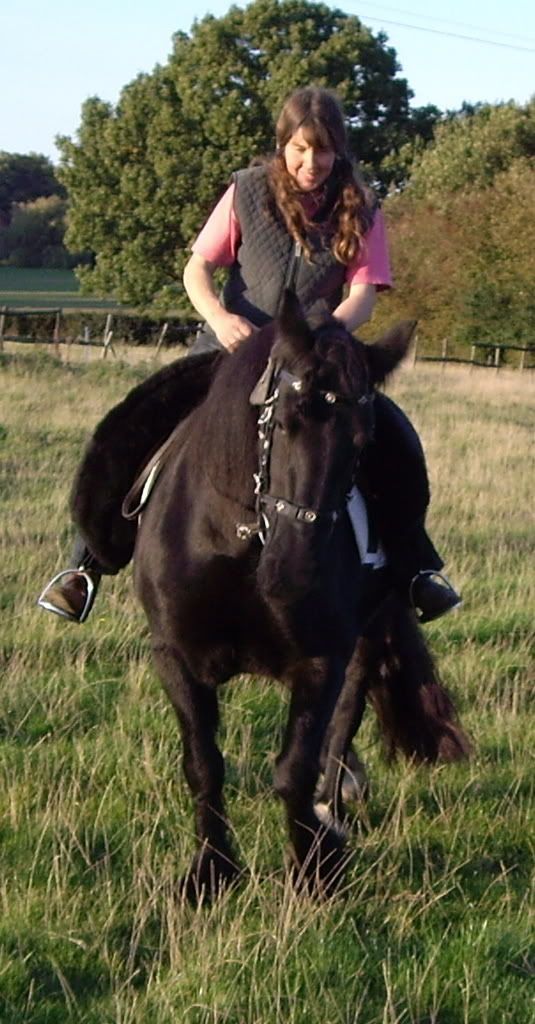
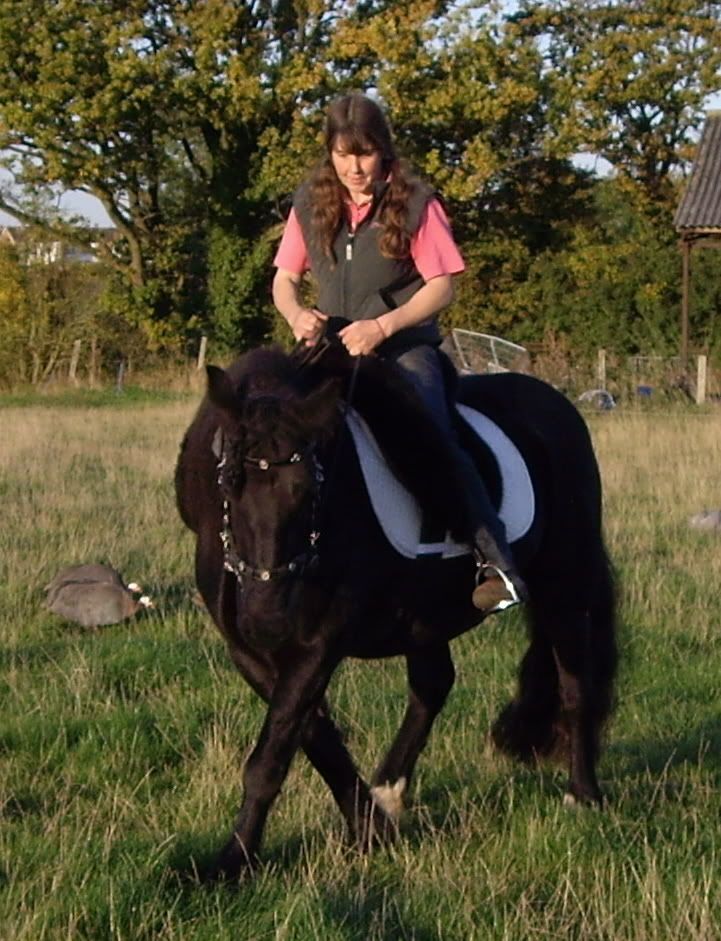
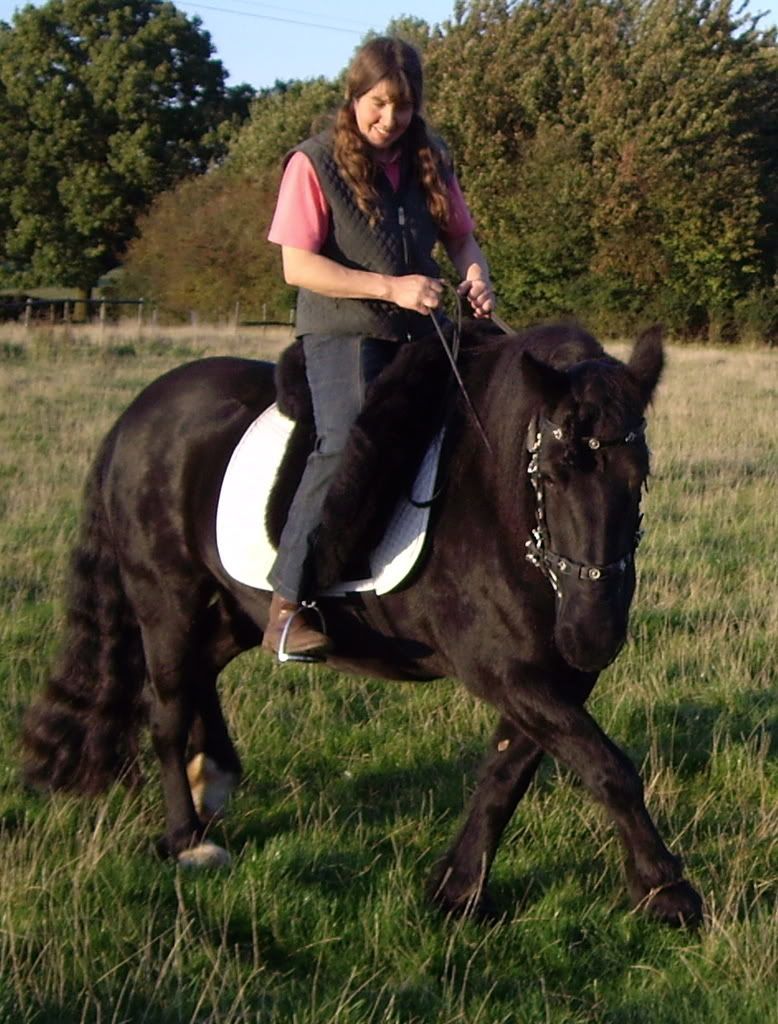
It's just wonderful to see him moving just for the love of it and he almost looks a bit disappointed when I click and he has to stop for his reward. He can't wait for an opportunity to show off his canter and his trot is starting to show some cadence now. He overtracks a mile in walk and his lunge work is relaxed, rythmic, willing and enthusiastic; everything I could only dream of before. He carries himself better than most horses do in side reins and he is just in a headcollar.
The icing on the cake tonight was when, just after I had clicked and he had stopped and turned to face me, waiting for his treat at the back of the school and quarters towards the bales - his most vunerable place and position - a quad bike whizzed along the track behind the school and made him jump. His muscles flinched and his head went up but he stood firm and dropped it again just as quickly. Needless to say he has never had so many treats in one go before!
He has NEVER been able to do that before. In the past, even if he didn't shoot off, he would have had to wheel around to face the bales and try to see what was going on, but this time he did what we have been practising with the 'Why Would You Leave Me' and kept his attention on me, leaving me to do the worrying and make the decisions.
I don't suppose that it will happen everytime something spooks him but the fact that it has happened once (and we have never had a quad bike go past when we were in the school before) and in that particular place and situation is just a massive step forward.
We are developing so much confidence in each other now. At this rate I'll soon be looking forward to things like that happening, just to test us out. When I start to feel like that I'll know that we have a rock solid partnership. We're not there yet but I believe that it is going to happen!!!
I walk around the school with them walking alongside me on a loose leadrope, then very slowly put my free hand on the leadrope and very slowly run it down the rope a short way, asking them to flex slightly towards me. With Jack and Grace I am looking for, and clicking, a soft sideways and slightly downwards flexion - with Jack for confidence and with Grace to try to counteract her habit of always coming above the bit whenever she is asked to do anything - and with Bella I have been clicking a sideways and upwards softening, as she tends to want to carry her head and neck rather low.
After several days of this I rode them all yesterday. Grace is so much better and did some lovely, soft work in walk and stayed attentive nearly all of the time. We managed some very passable rein back to walk transitions and she even managed some halts without coming above the bit. I am not kidding myself that this is going to be easy to carry forward into trot, and I think that we are going to have to do a lot of work in walk to get her balance very well established first, but for the first time yesterday I felt that I could actually push her neck out infront of me in transitions, instead of it coming back at me. Having her REALLY listening makes the world of difference because I can make subtle suggestions with my seat, to draw her back up under me, that she just wouldn't have heard before.
Jack is back to being Mr Cool and I think that I need to learn a lesson here. I think that the reason the cat episode had such a longlasting effect on him was because I had thought that he didn't need the low headcarriage work anymore and was always riding him quite 'up'. I MUST make sure that I encourage plenty of the 'down' work too. The only problem with finishing sessions the way that I do, with something really good (usually in an 'up' carriage) followed by a dismount and jackpot, is that he finishes on a 'high', which is great for his motivation and energy, but perhaps not so good for calm and relaxation. I think that I should finish with something very relaxing with Jack, with a low headcarriage, before I dismount, because he is always calm in hand now (and I never ask for 'up' in hand with him), and I don't want him to associate being ridden with being in a less confident carriage and therefore state of mind.
I couldn't believe the difference in Bella!!! As soon as I got on her she was 'up' and carrying herself beautifully. She felt a hand higher and like an elegant horse instead of the slightly clumpy family pony that she usually feels like when we begin on a long rein. I can never get over just HOW quickly you can make real changes with the clicker.
Bella is such a star, she spoils me rotten. Jack means the world to me but I have had to work really hard for all the progress that we have made. None of that's been his fault - just the way thing are and it's been very good for me. He's already taught me more than any other horse I've ever had - but Bella just hands me everthing on a plate! She is my rock, who keeps me believing in myself and the methods I have chosen for us all. She is very, very special!!!!
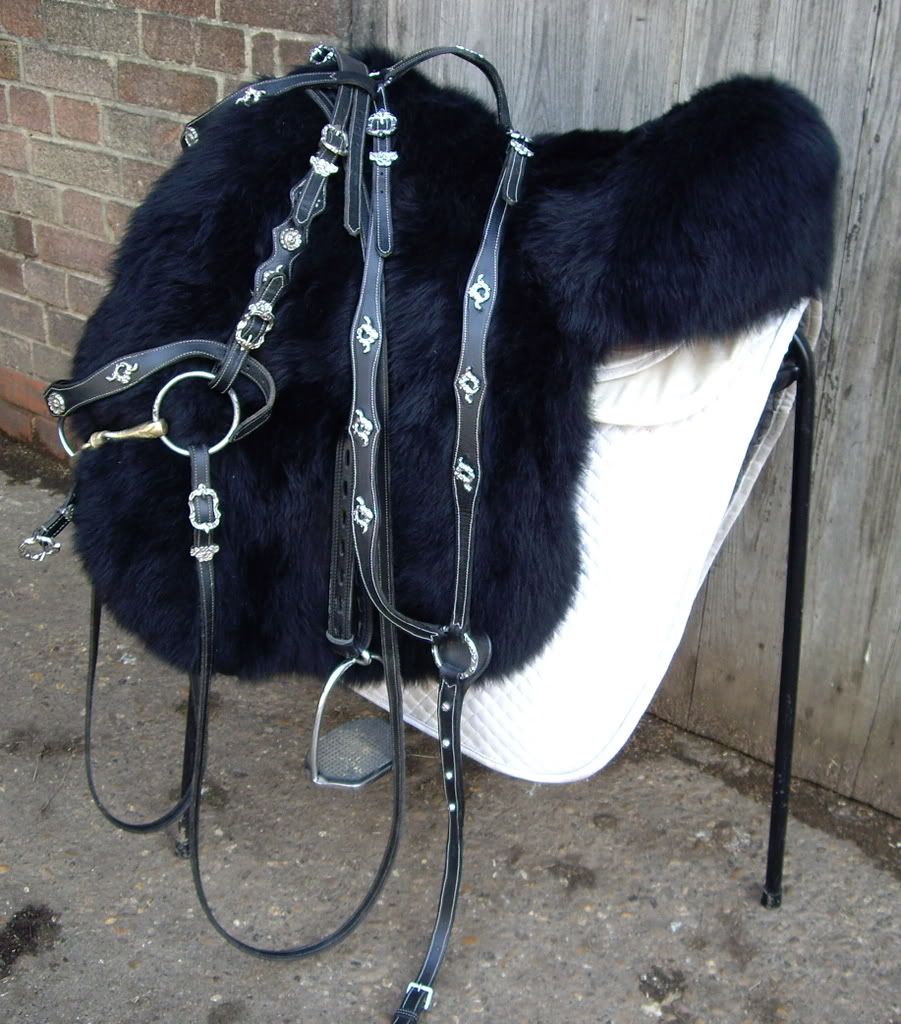

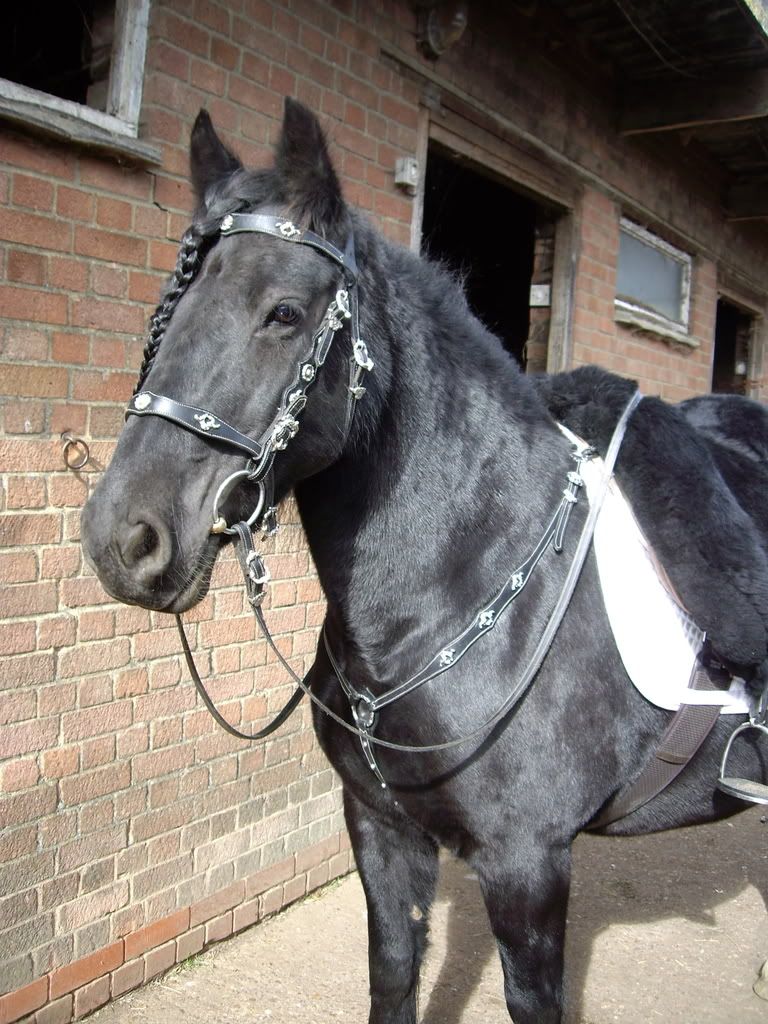
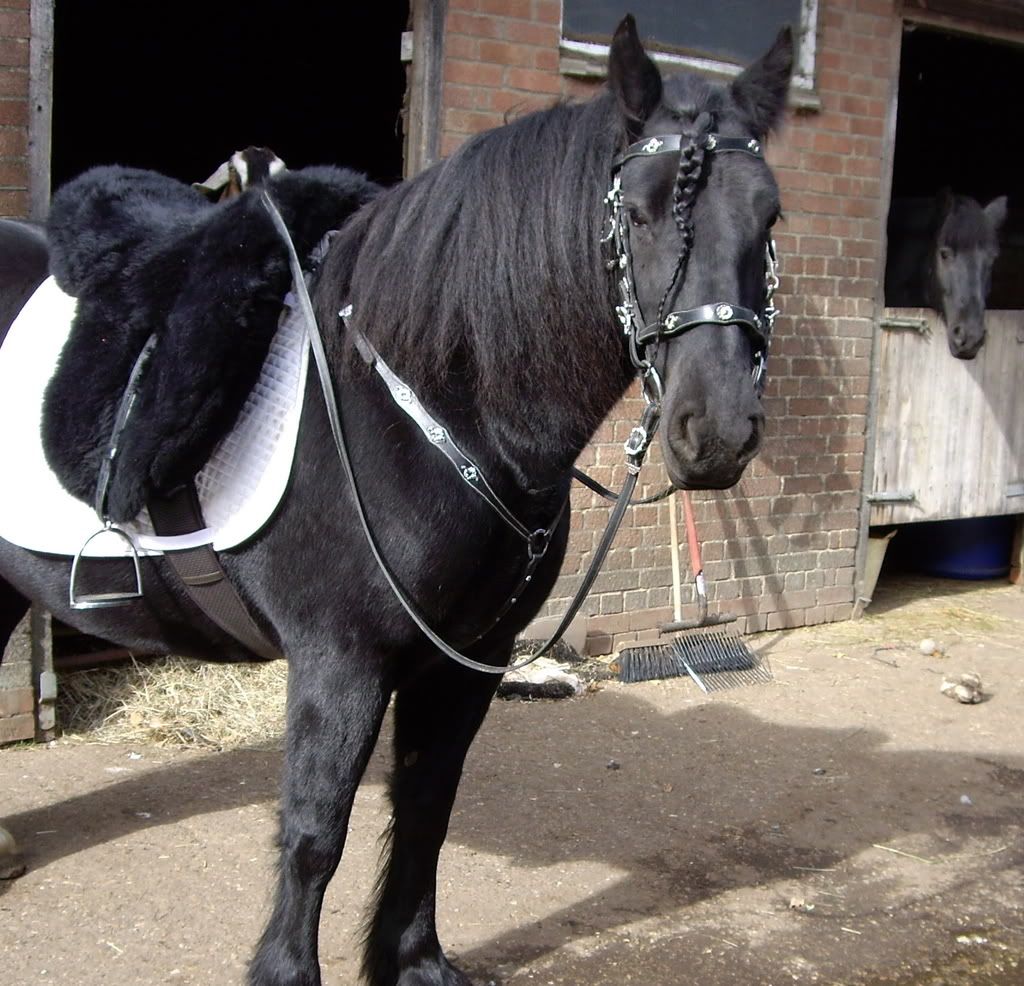
Grace has always been what I heard Mary Wanless refer to at a lecture demo as a ‘tourist’ of a horse. She has always been much more interested in what is going on around her than what her rider or handler is asking of her. Mary Wanless’s advice was to keep giving the horse a swift kick, to regain its attention. Alexandra Kurland’s solution is much nicer, and more effective, in my experience.
I am walking around the school with her asking for repeated lateral and slightly downward (as Grace's natural reflex is always to raise her head a bit too high whenever she is asked to do anything) flexions, by gradually taking a contact on the inside rein and asking her to soften to it, and then clicking and releasing as soon as she does so. Up to now Grace hasn’t really done ‘soft’ in any of her work and Bella and Jack have spoilt me when it comes to soft, so I was struggling to find anything to click yesterday, and had to relax my standards as to what qualified as soft. She also tended to fall in onto her inside shoulder and start to turn, rather than flex, so I had to walk back by her withers and use the rein as a ‘wall, to keep her up off her shoulder. She understands this from the previous Tai Chi Wall work.’
Today Grace's mouth was never empty, right from the very start of the session, the clicks and treats were coming so thick and fast, and we only managed twice around the school in each direction before my pockets were empty. This meant that I had her full attention practically all of the time, which is a huge improvement. She also stayed up off her inside shoulder without being reminded.
This is such a soft, gentle way of re-focussing the horse’s attention; just asking, releasing and rewarding, then asking again, and again, and again. It never seems to take very long before the horse realises that it is much easier to just concentrate, and the treats come faster that way too, but the horse still has the choice if he feels the need to gawp about between asks, so there’s nothing dis-harmonious or provocative about it – it’s all very polite and smooth, encouraging good feelings about staying with the rider/handler, mentally and physically, and it’s then an easy step into the single rein exercises under saddle.
We finished with a little leg yield in-hand. Grace moves sideways much more lightly and easily now, but once in the movement she tends to rush sideways and I need to work on slowing her down, getting her to wait for me and not to just use momentum to help her to pull herself through the movements
I know nothing of dance training or gymnastics but I have become an addict of the Strictly Come Dancing television programme and watching it I have picked up things that are really helping with dressage training. I have learnt that it’s slow movement that is difficult, requiring great balance, strength and muscular control, and that’s the way to get lightness, elegance and graceful movement.
Until recently I hadn’t done any proper in-hand work for ages, because I was enjoying riding too much. Now I am suddenly doing quite a bit again I’ve remembered why I love it so much. It’s so wonderful to be able to actually see improvements taking place, right in front of your eyes. I must try to keep more of a balance between the two in future!
He is such a lovely, soft, kind, willing, civilised horse to be with when he can hold his nerve. He was my hero today!!!!!
Jack seemed to handle it fairly well at the time but since then he has gone back to getting stiff and tense every time he goes around the top corners where he has to turn his hindquarters towards the bales. This is all quite minor, with none of the spinning and running that he used to go in for, but it's very disappointing when he was so confident. I did think of putting a contract out on the cat but then it occurred to me that perhaps this was the right time to see if he can give me the last part of the jigsaw needed for him to be a safe, reliable in all circumstances horse.
He has been really trustworthy since I began the strategy of giving him the reins and leaving him alone when he was worried, trusting him not to over-react and to think first rather than run first, but if I am ever going to be able to take him out alone in heavy traffic or anywhere where it's essential that he listens to me and stays under control, I need him to decide to accept my judgement and trust me to make the decisions for us both, especially when he can’t see whatever’s worrying him.
We both know that I can’t make him listen to me, and up to now he hasn’t been able to when he’s worried, and trying to get his attention back has always resulted in pushing him over the edge into flight, in those situations. I hope that he might now be able to trust my judgement enough to begin to hand control over to me, as I have done with him until now. Having him a bit nervous again in the school seemed a good opportunity to try, but the bottom line is that this is his decision to make. I can try to make it as easy and gradual a process for him as possible but it has to be his decision. He is too powerful and determined for me to be able to force it upon him, even if I wanted to.
I am starting with him in hand, to make it easier to ask for a low head carriage, and in a bridle, asking him to yield to a contact in all circumstances. The deal we have going at the moment is that if he softens laterally and in a downward direction when I take a light feel on the inside rein I instantly click and let go of the reins completely, so he is then free to take whatever course of action he sees fit. Of course he is highly unlikely to run away just then, as he is waiting for his treat, but I will not oppose him if he feels it necessary, as long as he has yielded momentarily to me first.
This is working SO well. It’s a form of Alexandra Kurland’s ‘Why Would You Leave Me’ exercise, around the whole of the school, but with at least double treats in the scary places. He has begun to stiffen and raise his head a few times, but then softened and dropped it again when I asked, giving me his attention back even though he is worried. This is a huge ask of him – a massive leap of faith and trust – and so far he has been able to manage it. I am even taking him into the school when he is bound to be at his most nervous (because he would be recovering his composure by now anyway), when the light is going and there is a lot of bird activity and sudden sounds and movements, and he has been consistantly brilliant, so far anyway.
I am hoping that the end result of this will be that he finds that if he listens to me even when he is scared nothing bad happens, and actually there was nothing to be scared of anyway. I am asking him to let me be the missing part in his field of vision and trust me to look after him in all circumstances. If he can’t completely manage that yet I will just have to work harder to prove myself worthy, but if he can then he will be the ‘special needs kid’ no longer and the world will be our oyster. It’s not going to happen overnight but I have begun to believe that it will happen, later if not sooner!
When I asked her to move her shoulders away sideways, instead of stepping under behind and pulling herself up through her withers and lifting her shoulders, as B and J do, she leant forward and got even more on the forehand, then pushed herself over with her front feet.
I didn’t want to work her in a bridle until she had learnt another way to move over, as I would probably have had to resort to quite strong rein aids. I took her into the school in a headcollar and used the leadrope, stretched between both hands and held up with one hand along side her shoulder, and the other hand very, very slightly in front of the point of her shoulder. This was in Tai Chi Wall fashion, to ask her to move over, just by holding it there and waiting until she worked out what to do, then clicking and dropping the tension from the rope at the tiniest weight shift. To begin with I was aiming for a slight weight shift back towards her hind quarters (but without her feet moving backwards), and then, when that was clicked and established, a step over, with the front foot nearest me stepping in front of the other foot.
When she could manage that easily I turned her head away from me slightly and worked on walk pirouette, clicking one step at a time.
This has made a tremendous difference to her self-carriage and lightness in hand in just a few sessions. She is starting to move over with much more ease and grace (excuse the pun!). It’s made me realise just how much Bella and Jack have already taught me and just how far they have already come. They move sideways like ballet dancers now, by comparison with how Grace moved a week ago. This is going to really help me with Grace because the missing ingredients are now so obvious to me, from all the time I’ve spent watching them move.
This work must be so good for them and their long-term soundness prospects – to be able to use themselves so efficiently and lightly. I wish I had had some dance training when I was young!
Bella has a small cut on her lip (probably the result of fighting with Jack over the fence – clicker training them to get on with each other has not been spectacularly successful!!!), so rather than risk her full cheek snaffle rubbing it I have been riding her in a headcollar for the last few days.
If it hadn’t been for the fact that I was using two lead ropes instead of reins I would have forgotten that she was not in a bridle. She is every bit as light and responsive, and we went through all the normal movements, even going from one lateral movement to another by changing the bend, with just as much ease as with a bit. She follows my seat and breath aids and needs very little else in the way of aids now.
We did some walk to canter transitions and she still has yet to strike off on the wrong leg, since we began following Philippe Karl’s instructions on his DVDs. She performs really enthusiastic, expressive canter transitions (I can see her inside front leg swinging out high in front of me, really using her shoulder) but still doesn’t like staying in canter very much under saddle, so I am not going to withhold the click to try to get more when riding just yet because I think that, at the moment, she would just lose enthusiasm for the transition. Cantering is very hard work for her (Dales historically were not encouraged to canter at all, and it used to be acceptable, in a mixed Mountain and Moorland class, to miss out the canter if you were on a Dales. Traditional ridden classes at the breed show still only involve walk and trot, and a lot of Dales seem to struggle with canter). I need to build duration very gradually, as she starts to find it easier. The last thing I want to do is to start pushing and risk losing her volunteer status.
We finished today, in the late afternoon, early autumn sun, with some rein back to trot transitions; rein back from just a lift of the leadropes and into trot from a breath aid, and going on in a few steps of collected trot - all beautifully balanced and engaged, and just in a headcollar!
It occurred to me, in those warm, sunny, moments of total harmony, that life really doesn’t get much better than this!
Another small Charles De Kunffy quote, from Dressage Questions Answered:
“It is tremendously important to yield to our horses. Nothing should ever freeze when aiding; nothing should ever be locked; nothing should ever be rigid. Riding is dynamic; it is perpetual movement therefore it tolerates no rigidity, which is the stopping of motion. Should any part of the rider become stiff or rigid the horse will have to become rigid. If any part of the rider is stiff the whole system suffers discord, and correct gymnastic development is at an absolute end.”
| |
On the lunge Bella now strikes off correctly anywhere in the school, with no need of the bales to set up the transition, and offers a balanced working canter from walk (they have both decided that they prefer to access canter from walk now). I tried it ridden for the first time over the weekend. First I asked for canter on the right rein, from walk, and she instantly responded with a correct strike off and a much improved canter.
Then for the tricky left canter strike off. I was fully prepared for it all to fall apart with me added to the equation but again Bella went from walk into an easy left canter that surprisingly felt even better than the right canter. So it has continued, with correct leads each and every time. I am just amazed – speechless really – it was, is, so easy, when it was so difficult just a short while ago.
I also wanted to see what her enhanced trot, that she now offers all the time when ridden, actually looks like. She has never trotted like that on the lunge so I had to withhold the click until it occurred to her to try her ‘ridden’ trot. OH WOW!!! It’s beautiful! It has rhythm, cadence, swing, elevation – the sort of trot that you just don’t expect to see from a stuffy, cobby little Dales, and when I held out for a bit more she lengthened with absolutely no hint of hurrying and was significantly overtracking, and I could see that there was still more there to be had at a later date! I don’t know if it looks as good as that with me on top, but it feels wonderful, so I don’t think that it can be far off.
This is the first thing that I’ve taught her ridden first, rather than in hand first, and it’s a trot that Bella didn’t know that she was capable of, let alone me. I am SO thrilled with her!!!
Jack has decided that a collected canter is what is required on the lunge and he now goes from walk to canter without me even suggesting it, and canters a tiny circle around me at walking speed! He looks like a showjumper approaching the Puissance wall! He was throwing his head very high into the air, to get his weight far back enough to produce such collection, and he was so pleased with himself that, although I wasn’t aiming for such extreme collection (think of the sort of canter you see just before a walk pirouette) I didn’t want to discourage him. I wanted to get a bit more forward movement, to male it easier for him, but without losing his enthusiasm or trying to drive him forward (which I have sworn never, ever, to do to him again). I tried walking with him and just withholding the click until his nose dropped out of the sky a little.
He must have decided that cantering with his head in the air was very uncomfortable anyway, because it only took about two clicks before he was shifting his weight back onto his quarters by pulling upward through his withers instead. He is still offering a lot of collection, so I think that I will continue with only cantering him on the lunge for the time being, until he can carry himself like that with ease or until he offers something more like a working canter, but it’s fabulous to watch and just doesn’t look like clumpy old Jack at all!
I just can’t believe that we have achieved all this already. I KNOW that I could never, in a million years, have got the quality of work that they are already producing, without clicker training. I didn’t know that they were capable of it and neither did they. Non of this is natural movement for them. They have never managed anything like this loose in the field.
This is all with no whip or spurs, and on the lunge no bridle, side reins or cavesson – just a head collar, We have managed all this with no force involved at all. It’s all 100% voluntary – the only tools required are a tongue to click with and pockets stuffed with treats.
I go up to the yard last thing at night, to make sure they have enough hay and skip them out (and turn on the baby monitor that we have in the tackroom and our bedroom, so we would hear if there was a problem in the night). Last night, while I was up there, I saw a shooting star. I very nearly made a wish, but then I thought better of it; that would just have been greedy!
Blog Archive
-
▼
2008
(122)
-
▼
November
(112)
- ‘Riding with the Clicker’.‘The Click that Teaches ...
- Some pics of Jack on Saturday, showing that he can...
- Some pics of Jack's eye, to show what he has to co...
- I have become a bit obsessed with rein back. Bella...
- Single Rein Riding.This might seem a strange thing...
- Operant Conditioning, etc.I meant to write this bi...
- Well, at the risk of speaking too soon, I think th...
- I have started working on Bella's canter, just the...
- Withholding the Click.I thought that saying that B...
- Another explaination!I thought that my strategy of...
- Quick Jack update.I rode him in a big field yester...
- Building Duration.For the past fortnight I have be...
- It only took about 5 minutes to fix Bella's should...
- Pressure as a Training Shortcut.I've been thinking...
- Rode Jack in the school today for the video. It wa...
- I rode Jack in the windy school again today and it...
- Working Long and Low.I have been thinking some mor...
- I am so pleased with and for Jack. For the last fe...
- I did some liberty work with them both tonight, as...
- More Freeshaping.I continue to be astounded by how...
- Riding Jack in the school I have kept to on the bu...
- I'm having practise at coping with frustration aga...
- I said yesterday that I couldn't understand why sh...
- I'm having terrible problems with Jack!. He has go...
- For the last few days one of the things I've been ...
- I have watched 'The Art of Riding' tapes again and...
- 'The Art of Riding' series are by Baron Hans von B...
- My riding dialogue with Jack has changed again. Be...
- Volunteer versus Conscript.Before clicker training...
- Jack exceeded all my wildest dreams tonight. It's ...
- A friend sent me this link. It's very poor quality...
- Bella and Jack had a very unusual joint day off to...
- Finally caught OH walking past while I was riding ...
- Some new bales of haylage have appeared in the sch...
- I was a bit frustrated that more flappy plastic ba...
- Appy2quarter and I have written a lot in our blogs...
- I have found that the real difference comes from ...
- One last quote from Charles De Kunffy's 'The Ethic...
- Had another lightbulb moment, courtesy of Mr. De K...
- I did more work on encouraging Jack to over-ride h...
- Another last quote from Charles De Kunffy's 'The E...
- I wanted to copy my part of a conversation I had w...
- SINGLE REIN RIDING.For Shoveltrash and anyone else...
- In his book, 'The Ethics and Passions of Dressage'...
- I read somewhere an interview with Anton Du Beke, ...
- Bella and Jack are now so 100% committed to workin...
- Philippe Karl has also provided me with the last l...
- I have felt the need to put my stirrups down anoth...
- Bella 24th August 2008. I was playing around with ...
- I think that I must have been a saint in another l...
- PHILIPPE KARL and CANTER.Philippe Karl explains, o...
- I LOVE Travers!!! Bella and Jack love it too, but ...
- I said in an earlier post that I couldn’t teach Be...
- Here are some pics of Jack, taken yesterday, Septe...
- I have just bought another Charles De Kunffy book,...
- I know exactly what I need to do, but I never seem...
- I know that some people have trouble working out h...
- Philippe Karl's DVDs have been worth their weight ...
- I'm having trouble believing that Jack is the same...
- I would very proudly like to introduce my new Baro...
- I have been having a wonderful time hacking out my...
- Jack has never quite accepted the concept of lungi...
- QuoteFor me learning to wait for the horse to offe...
- I have had such a lovely weekend. Bella and Jack r...
- I haven’t asked Bella or Jack to canter under sadd...
- I have just started doing some in-hand work with G...
- Poor Jack has suffered a bit of a crisis in confid...
- Jack was SO good today. We had 3 short sessions in...
- Grace is a very fast learner. For the last couple ...
- For anyone interested Jill Shephard's sheepskin sa...
- I was a bit short of time over the weekend and dec...
- It was Jack who was hero of the day today! Since I...
- I am SO, SO, SO pleased with Grace!!!! I haven't c...
- I finally managed to get a couple of pics of Bella...
- I also have one pic of her canter transition. I wa...
- Just to show the reverse side of clicker training ...
- A couple of people were watching me ride Bella on ...
- I have been working on Grace’s trot. I have to con...
- I've got to put these pics from my headcollar adve...
- I mentioned the 'Statues' game that I play with my...
- sI have been struggling to carry the lateral work ...
- I once went to a Kyra Kyrklund lecture demonstrati...
- I've just GOT to put these two pics of Bella on he...
- A few days ago Alexandra Kurland posted a 12 page ...
- I had two real breakthroughs today. Although all t...
- When I think canter my body (core) arranges itself...
- I have had the maddest afternoon! I worked all thr...
- Hello Muriel. Thank you SO much for the comments! ...
- I really would love it if you would leave comments...
- On her ‘Three–Flip–Three: Lateral Flexions’ DVD Al...
- My imaginary reins failed me today! After I had fi...
- I'm reading Dominique Barbier's book 'Dressage For...
- Jack amazed me today. I haven't had much time for ...
- Just when I think that I've got used to the tremen...
- I'm really, really excited today! My new Click tha...
- Muriel asked another really good question (thank y...
- It was very cold and windy here today with a lot o...
- I have now watched most of one of the new 'The Cli...
- Maryka asked me to explain the mechanics of single...
- I am SO glad that I bought Alexandra Kurland's lat...
-
▼
November
(112)
Followers
About Me
- Helen
- I am a clicker training addict and there is no cure - thank goodness!!!
